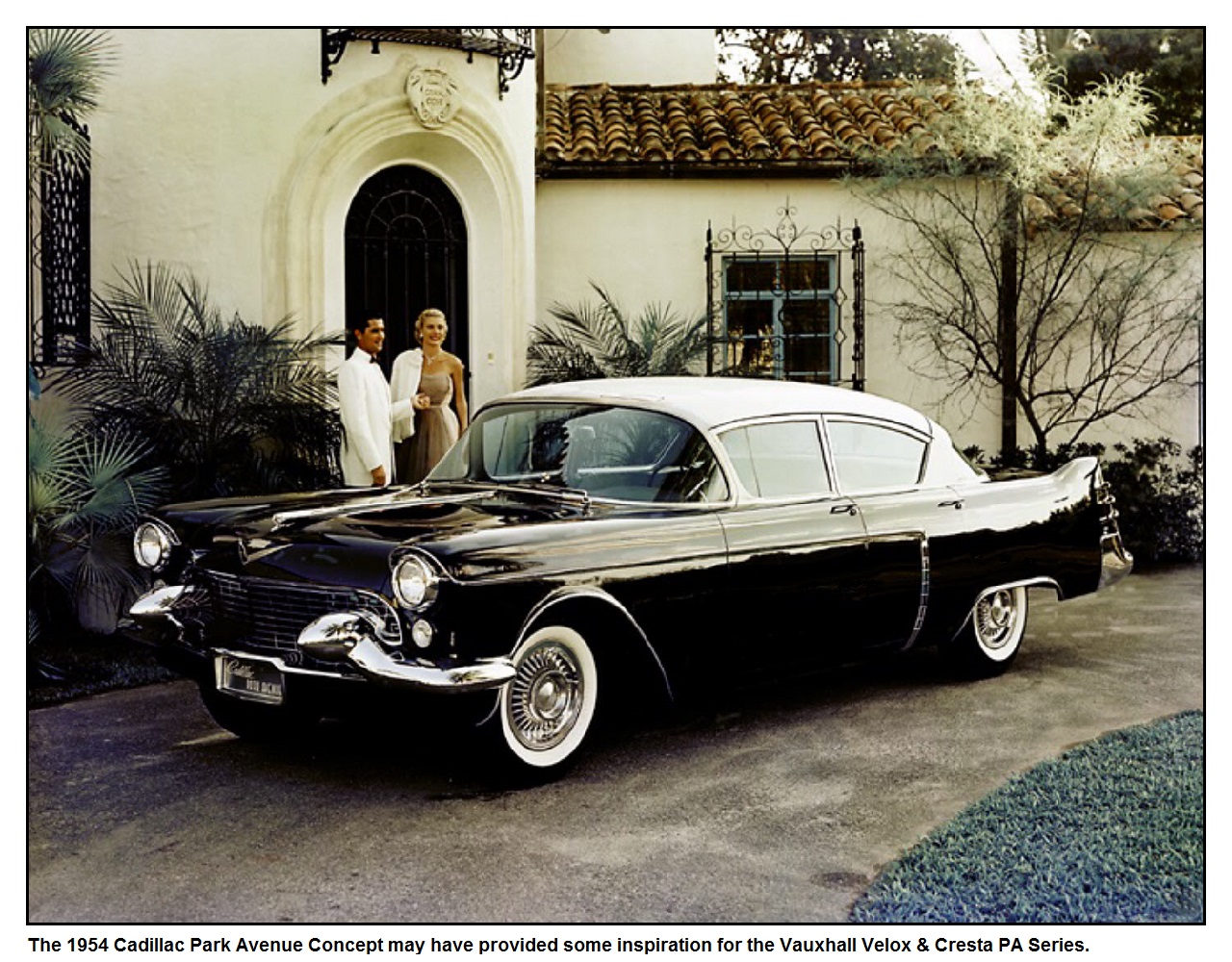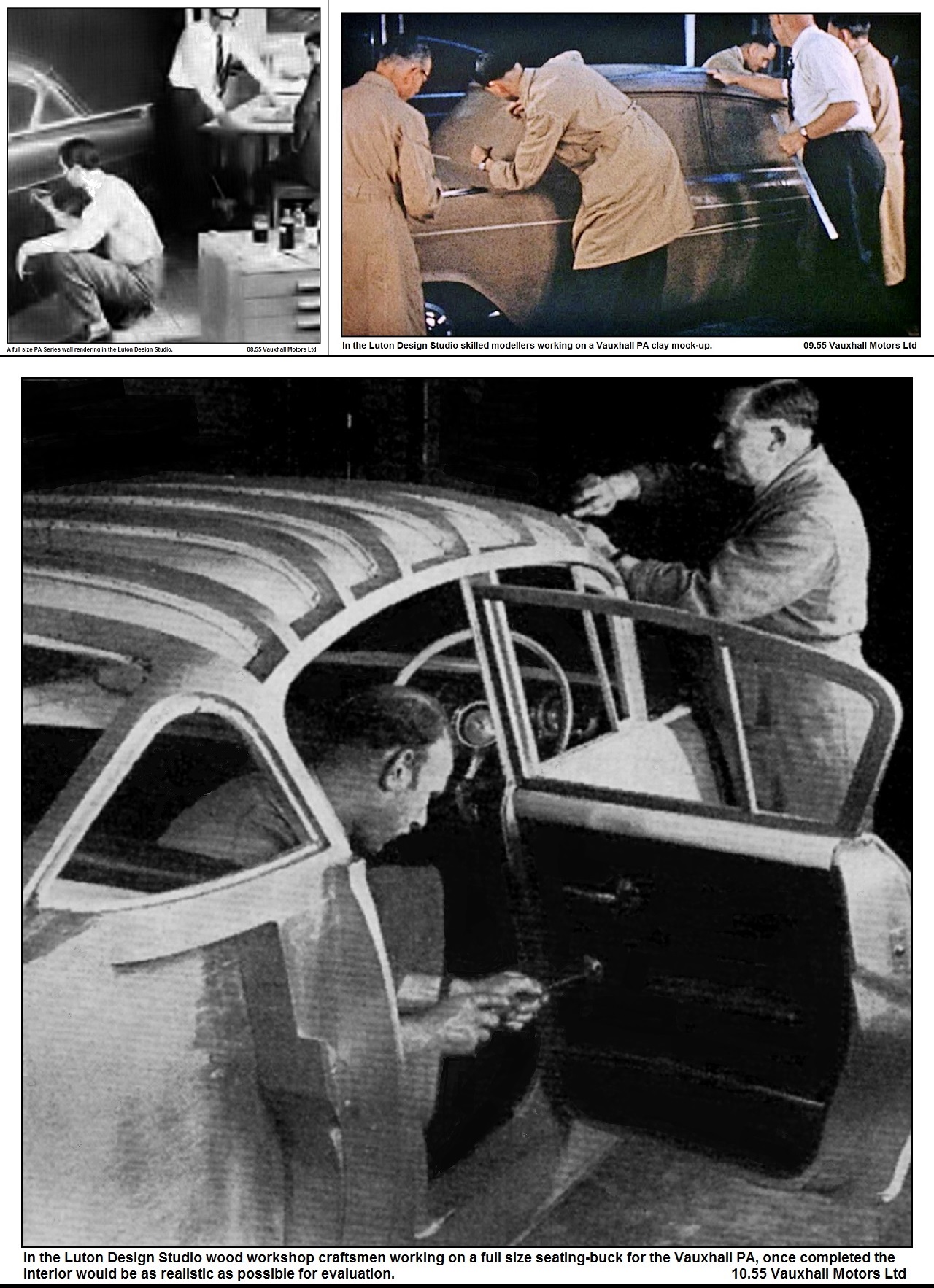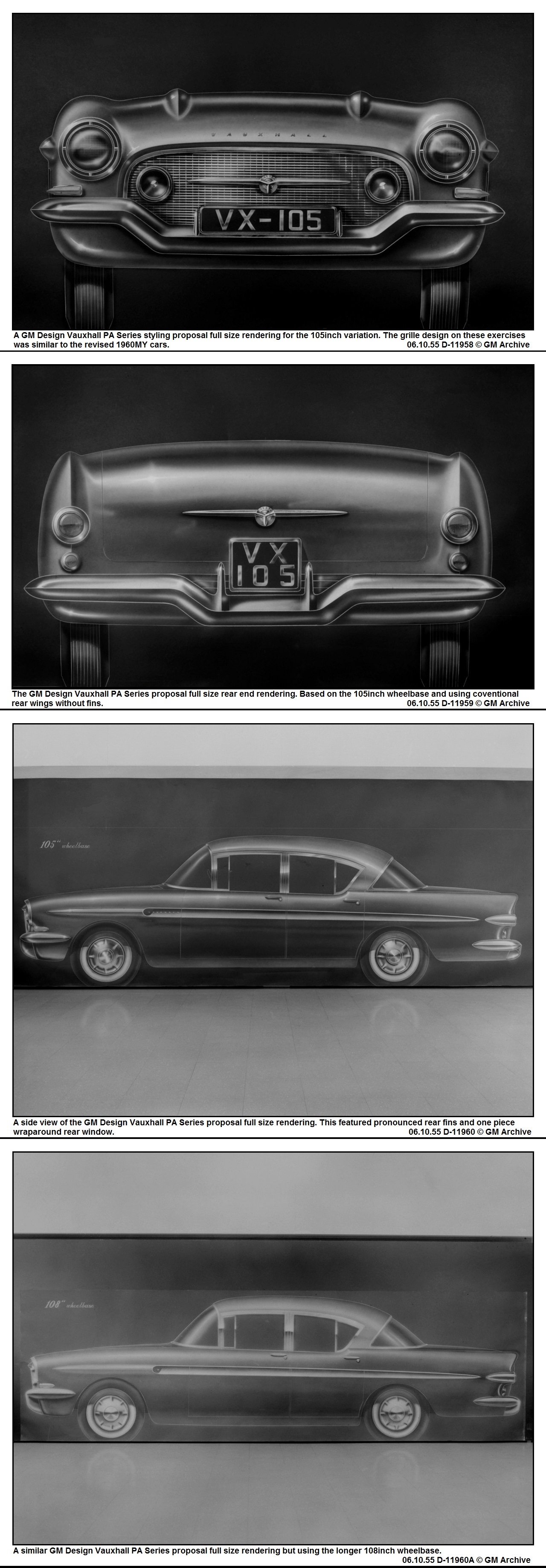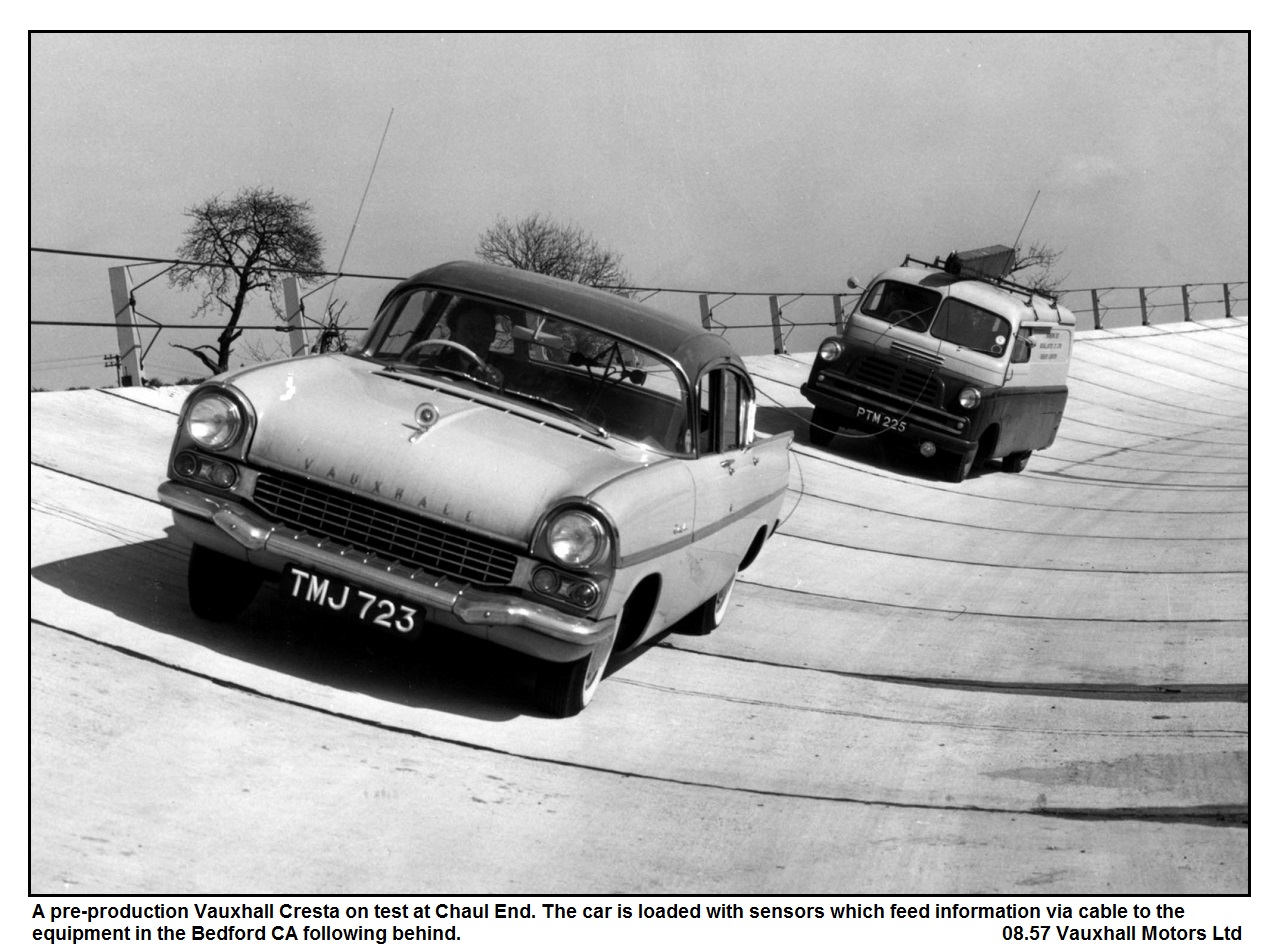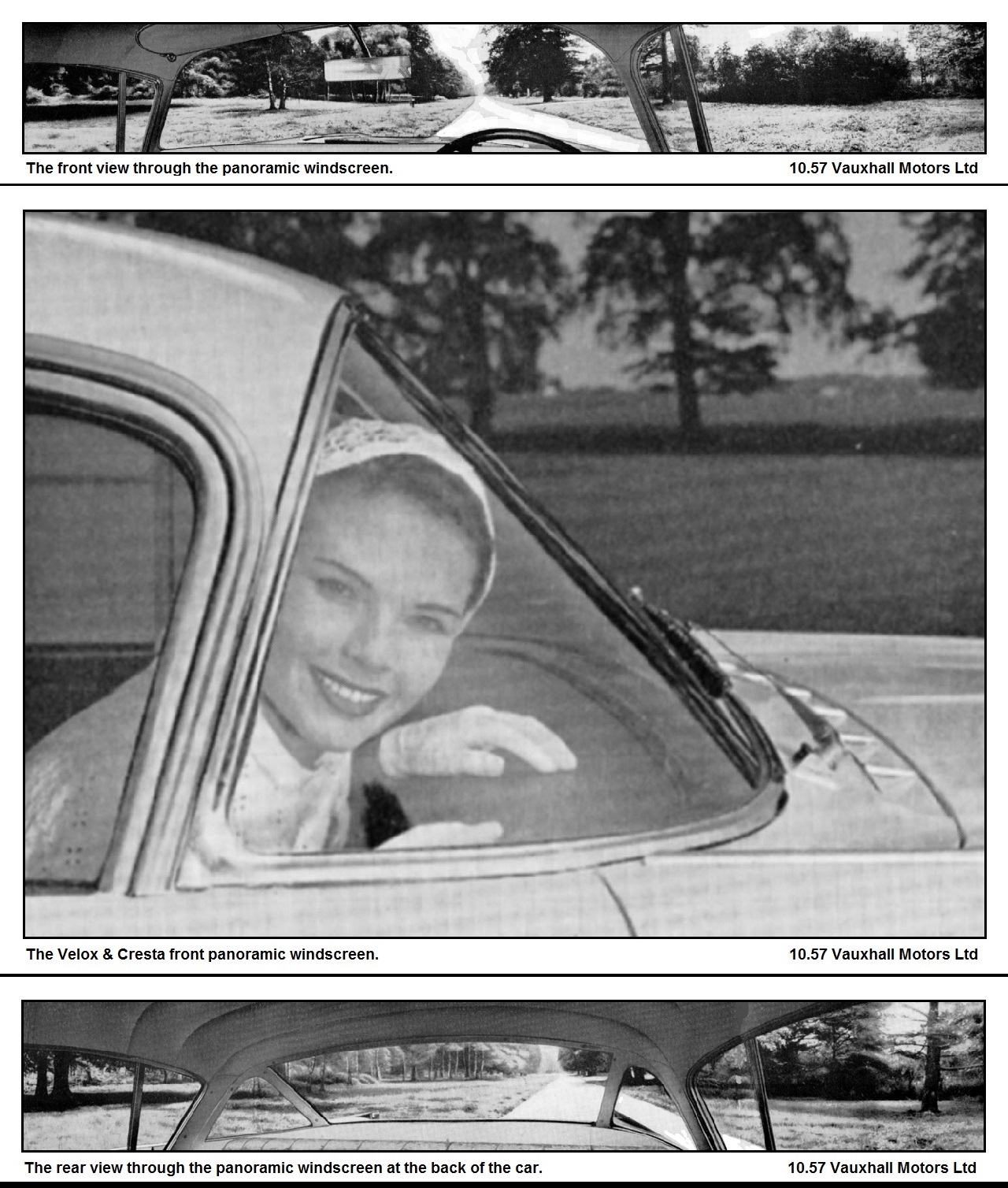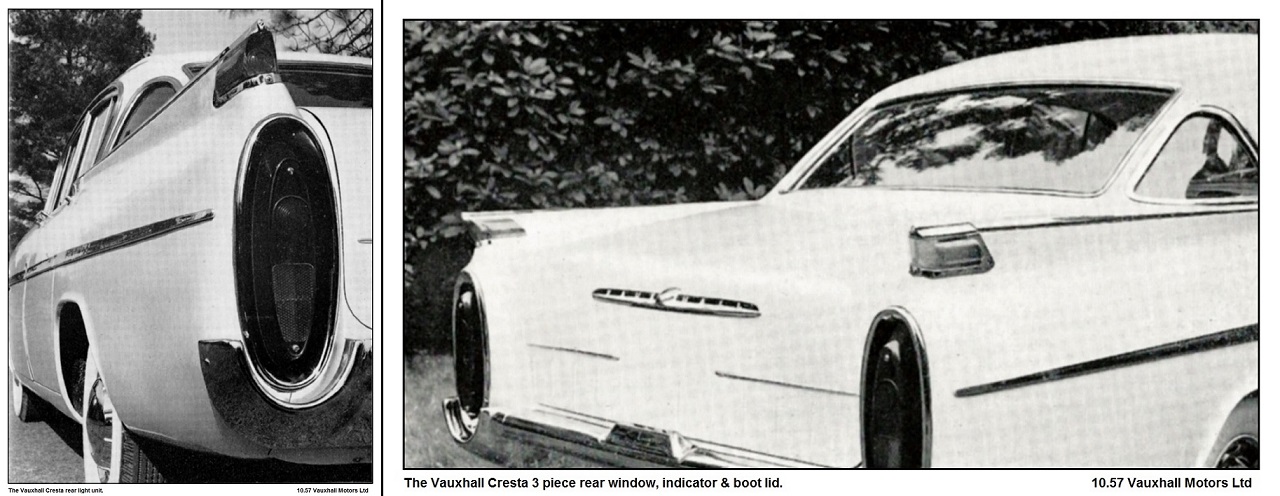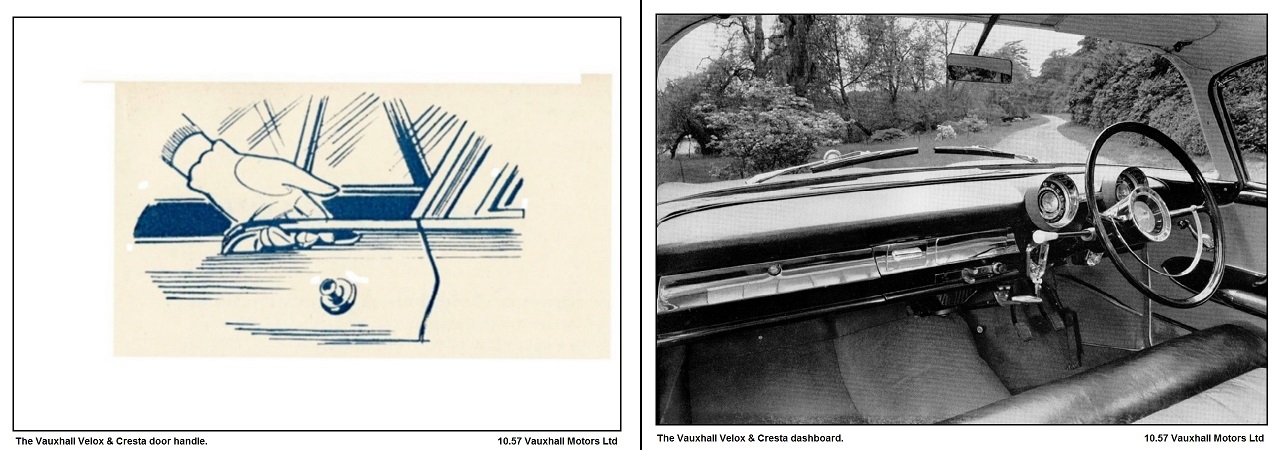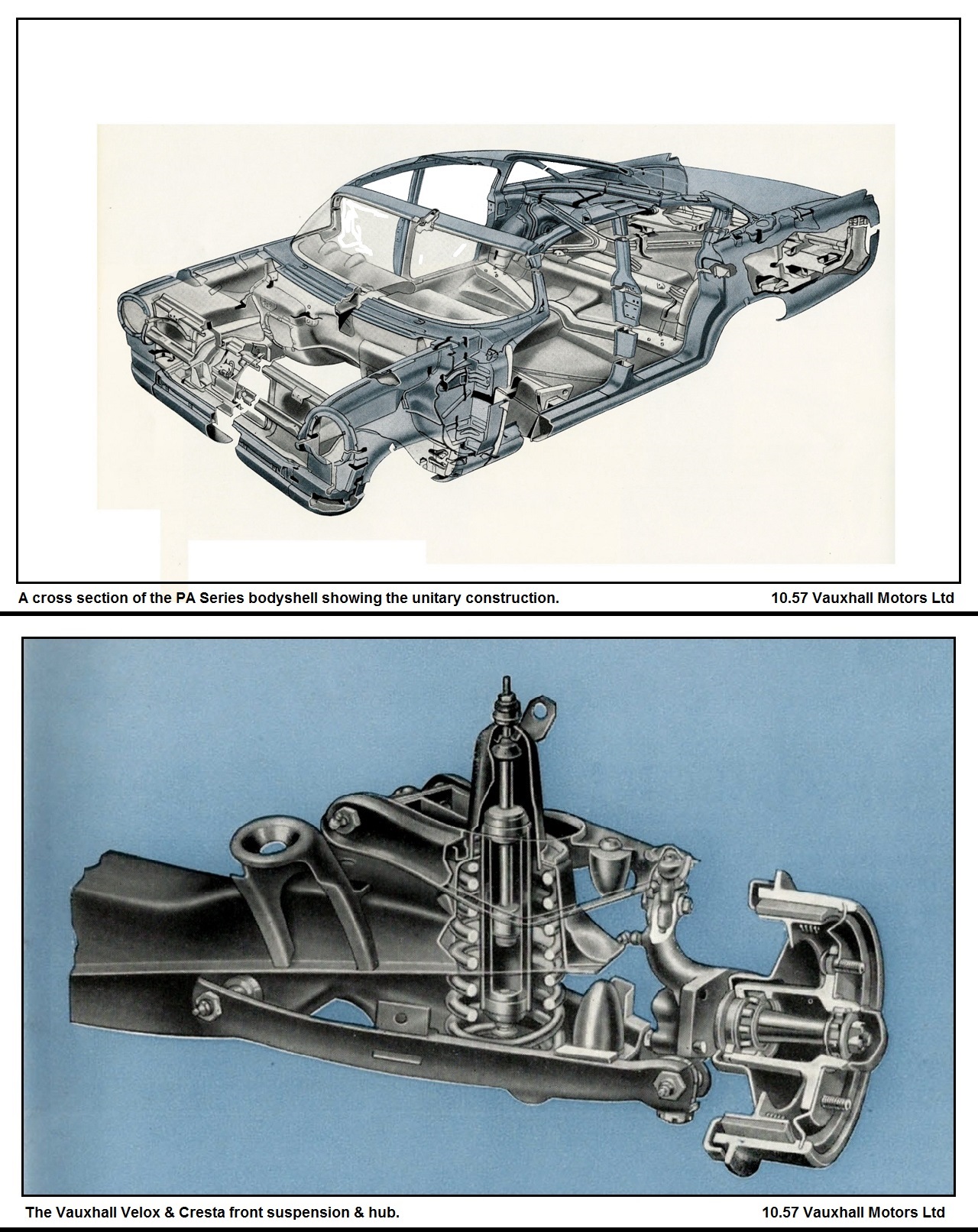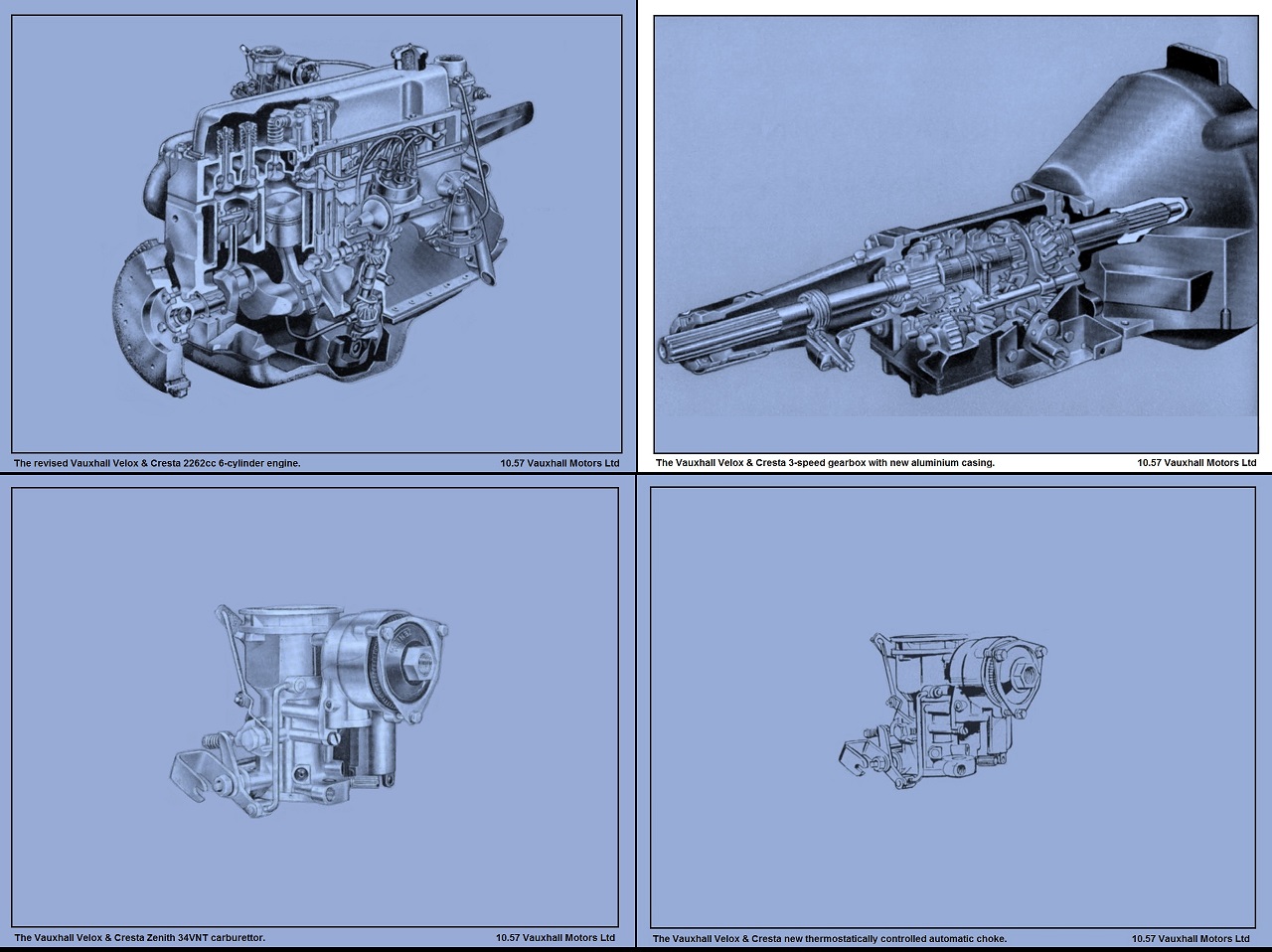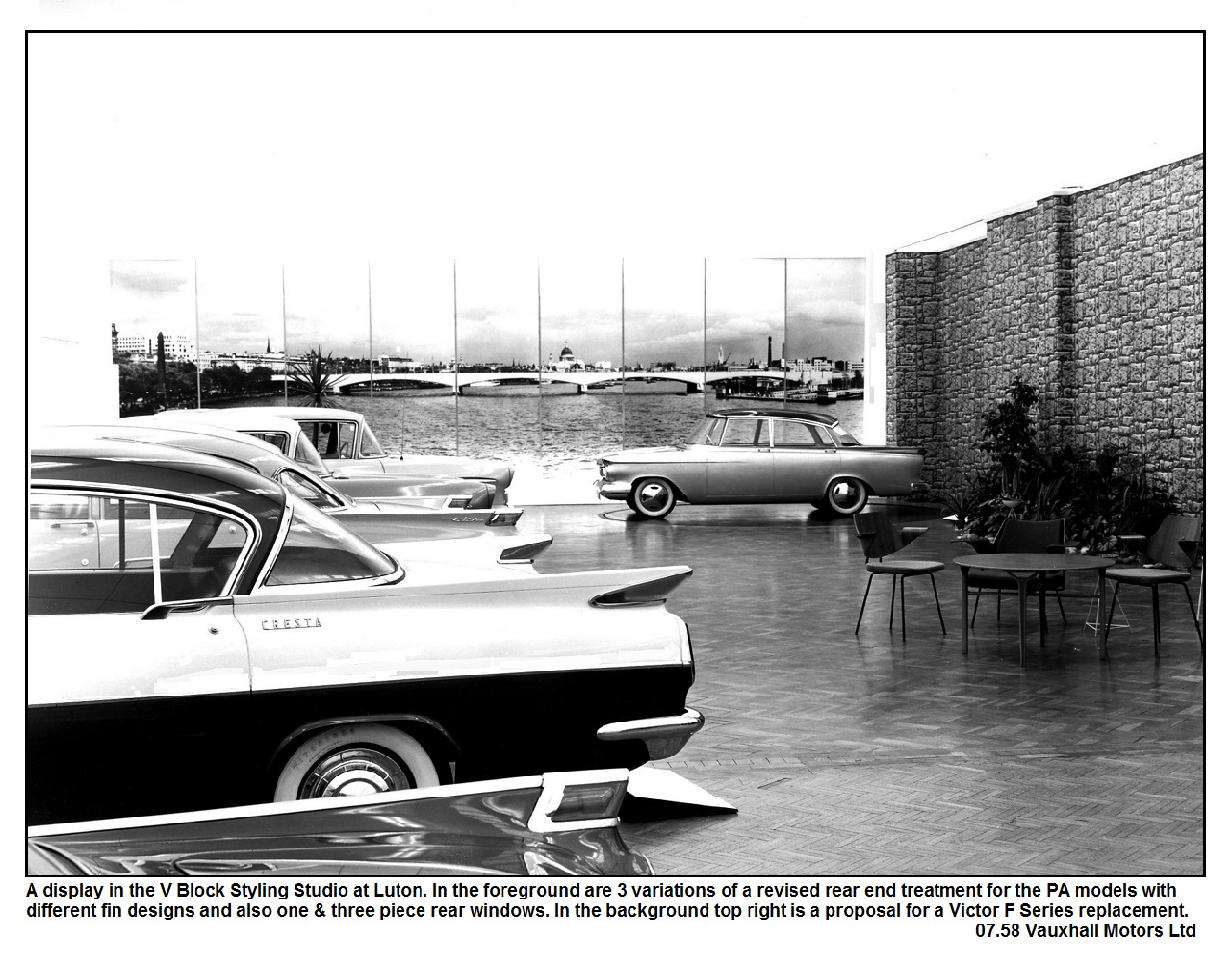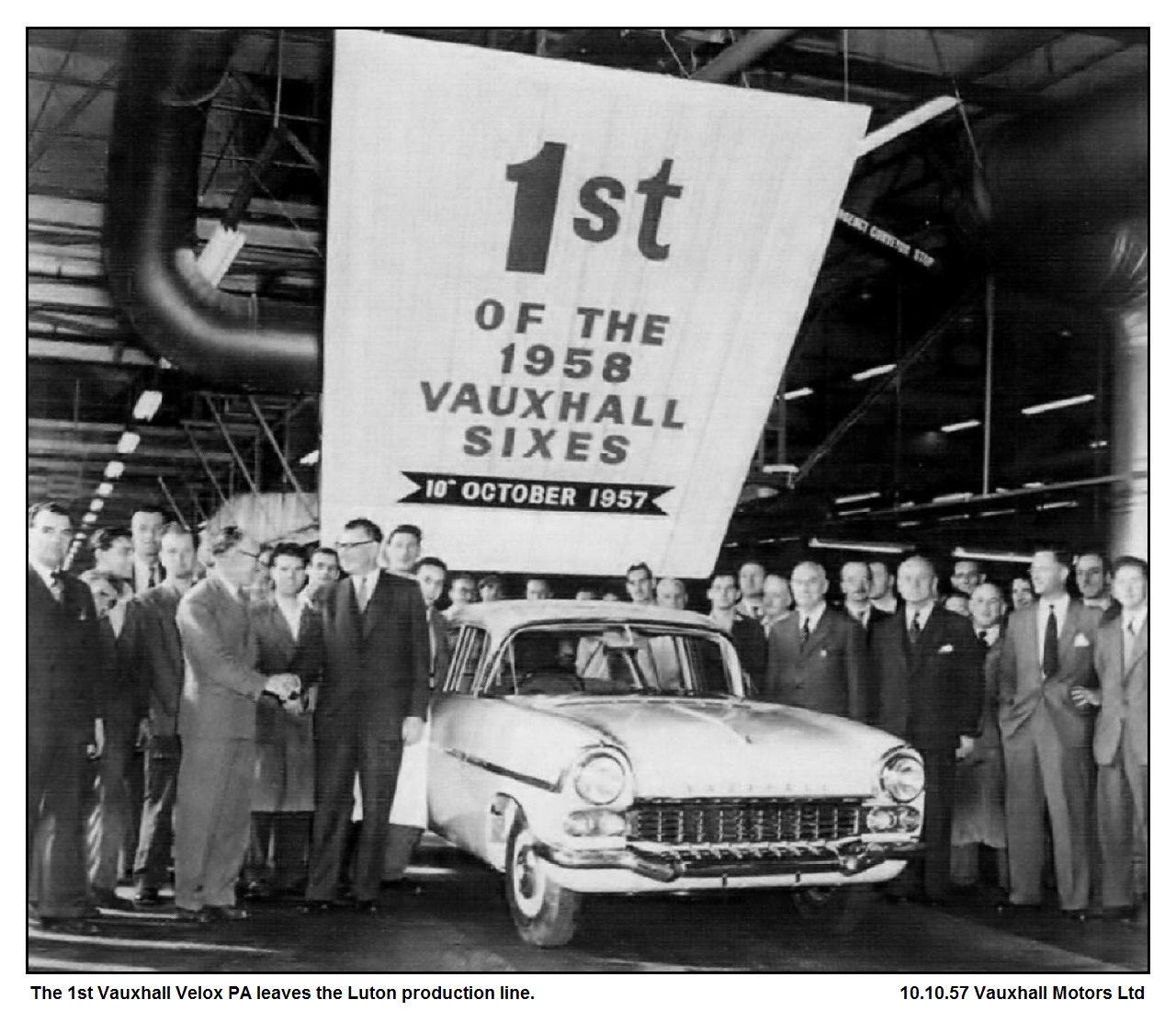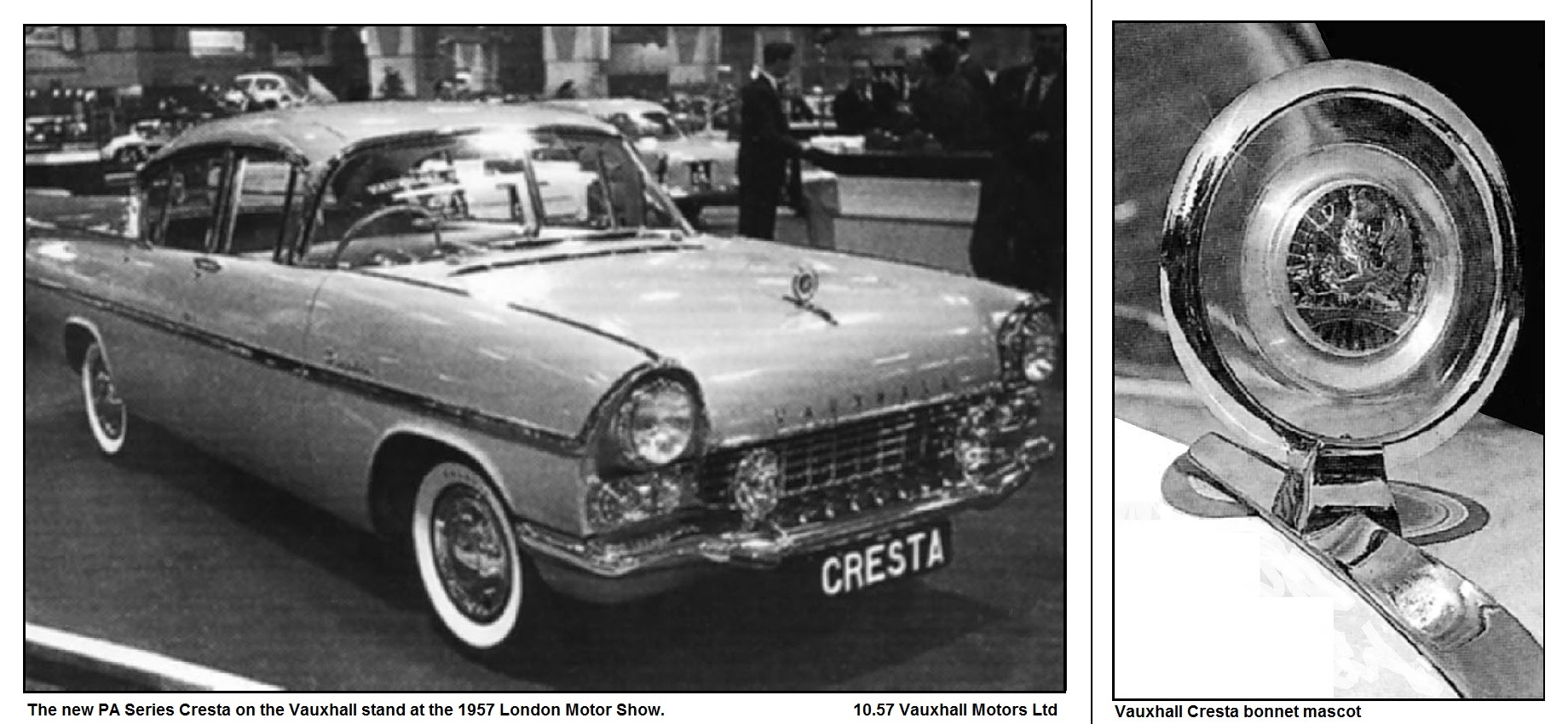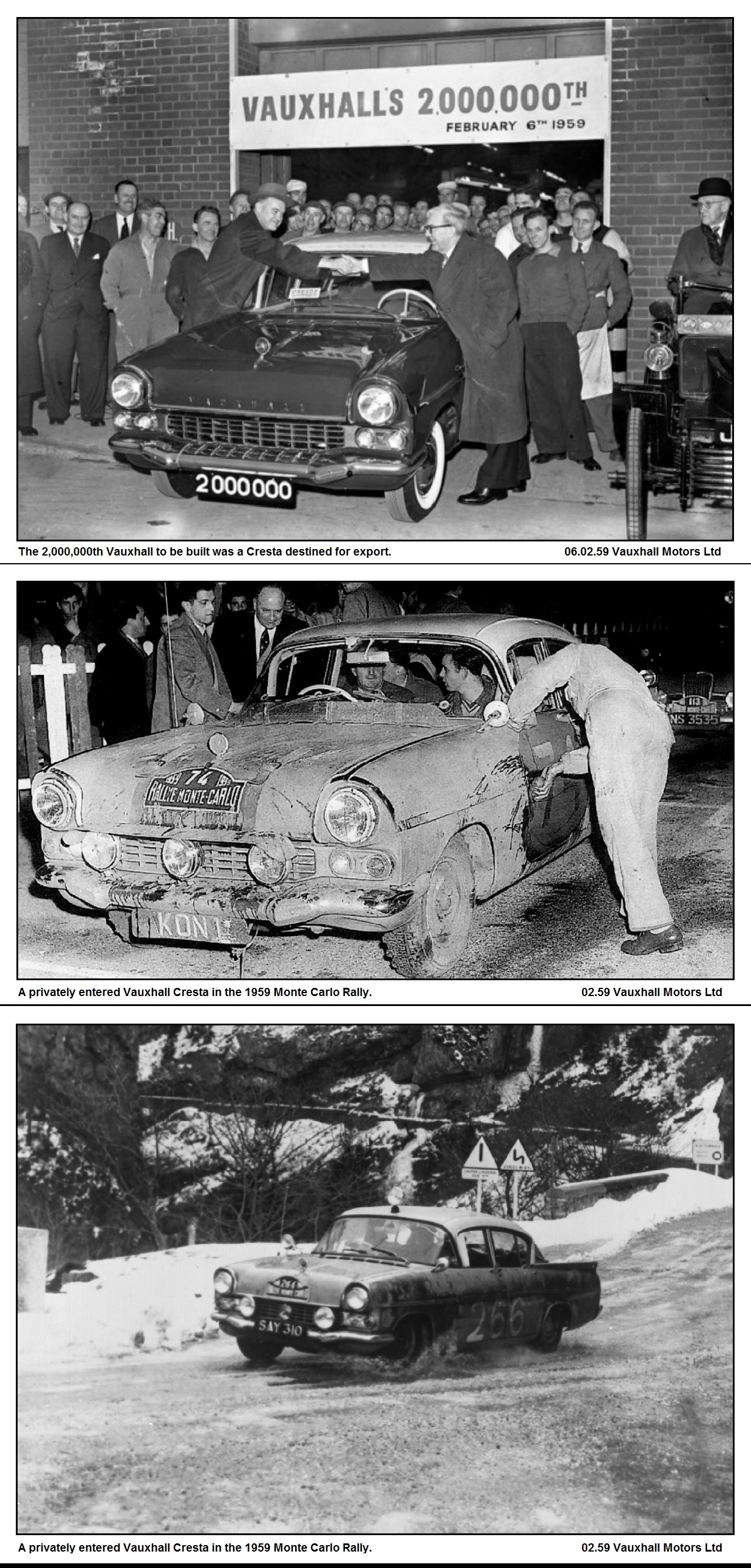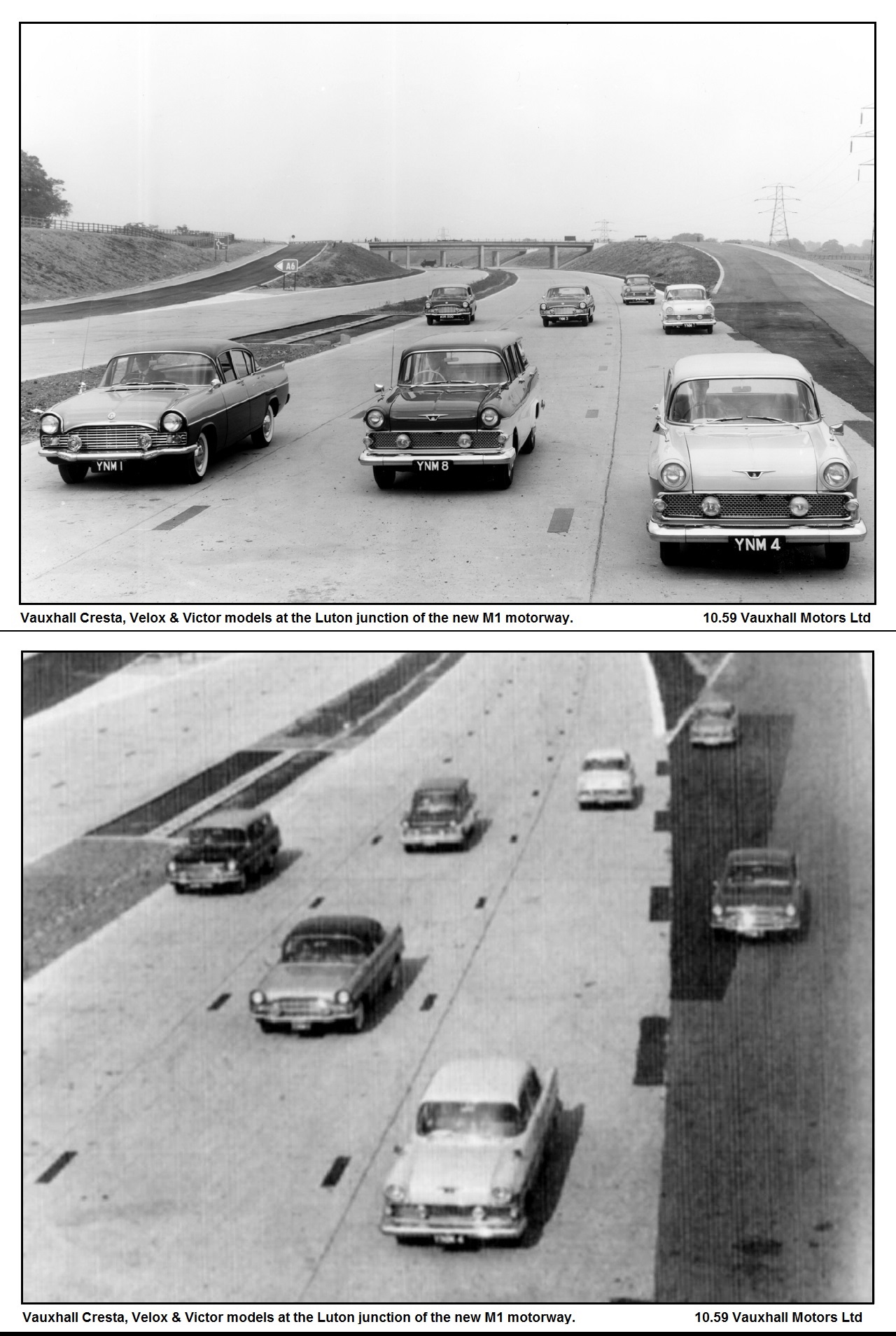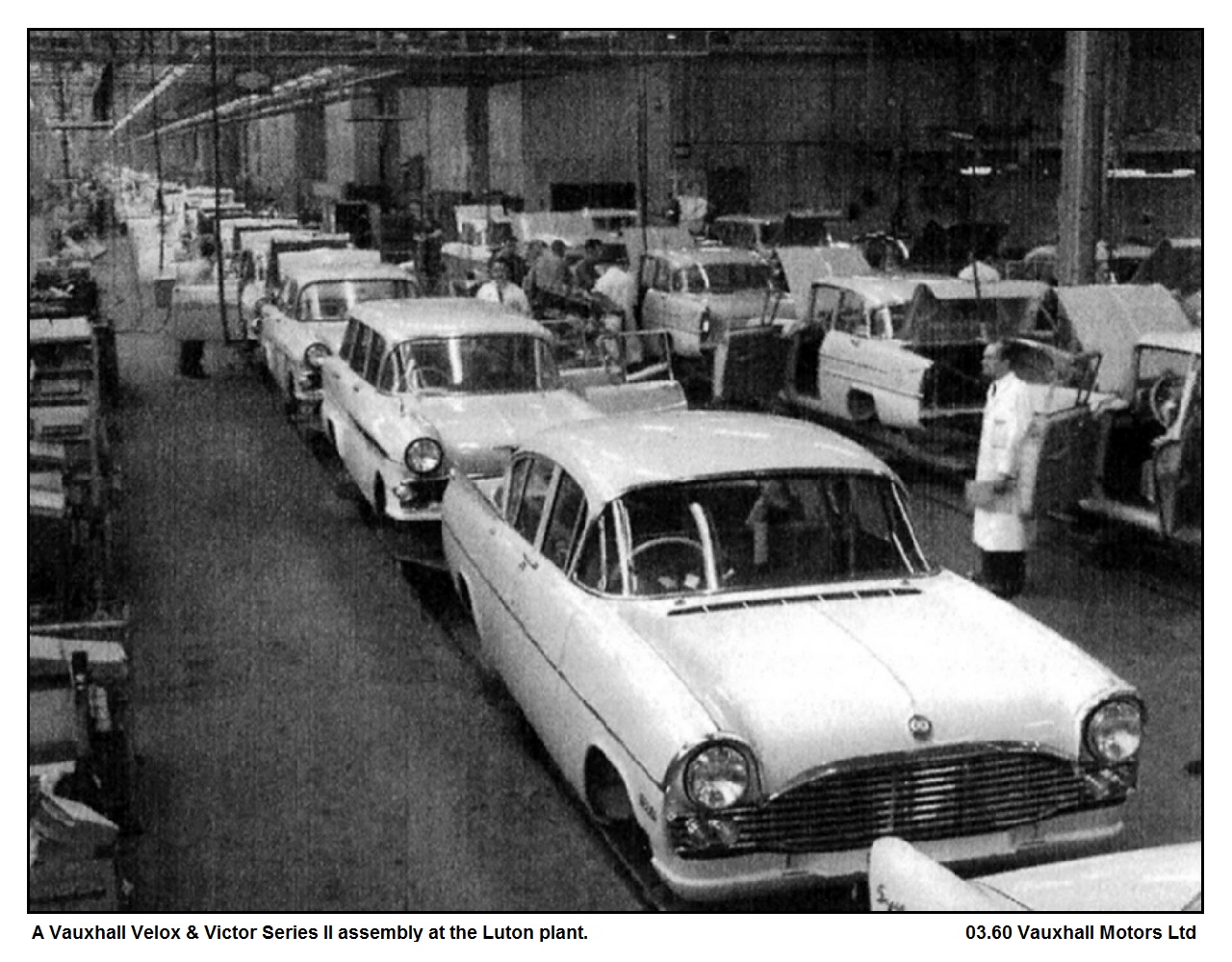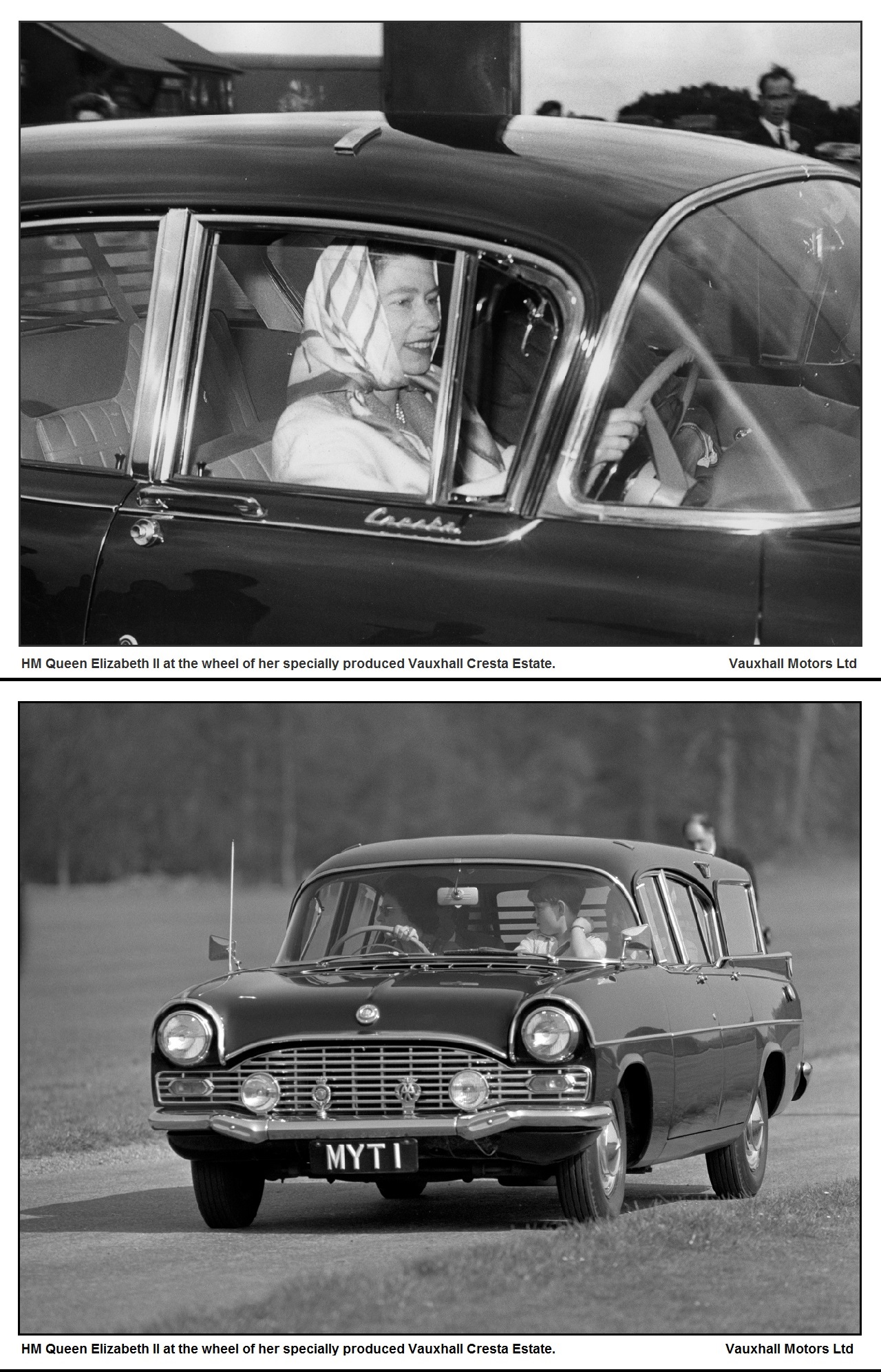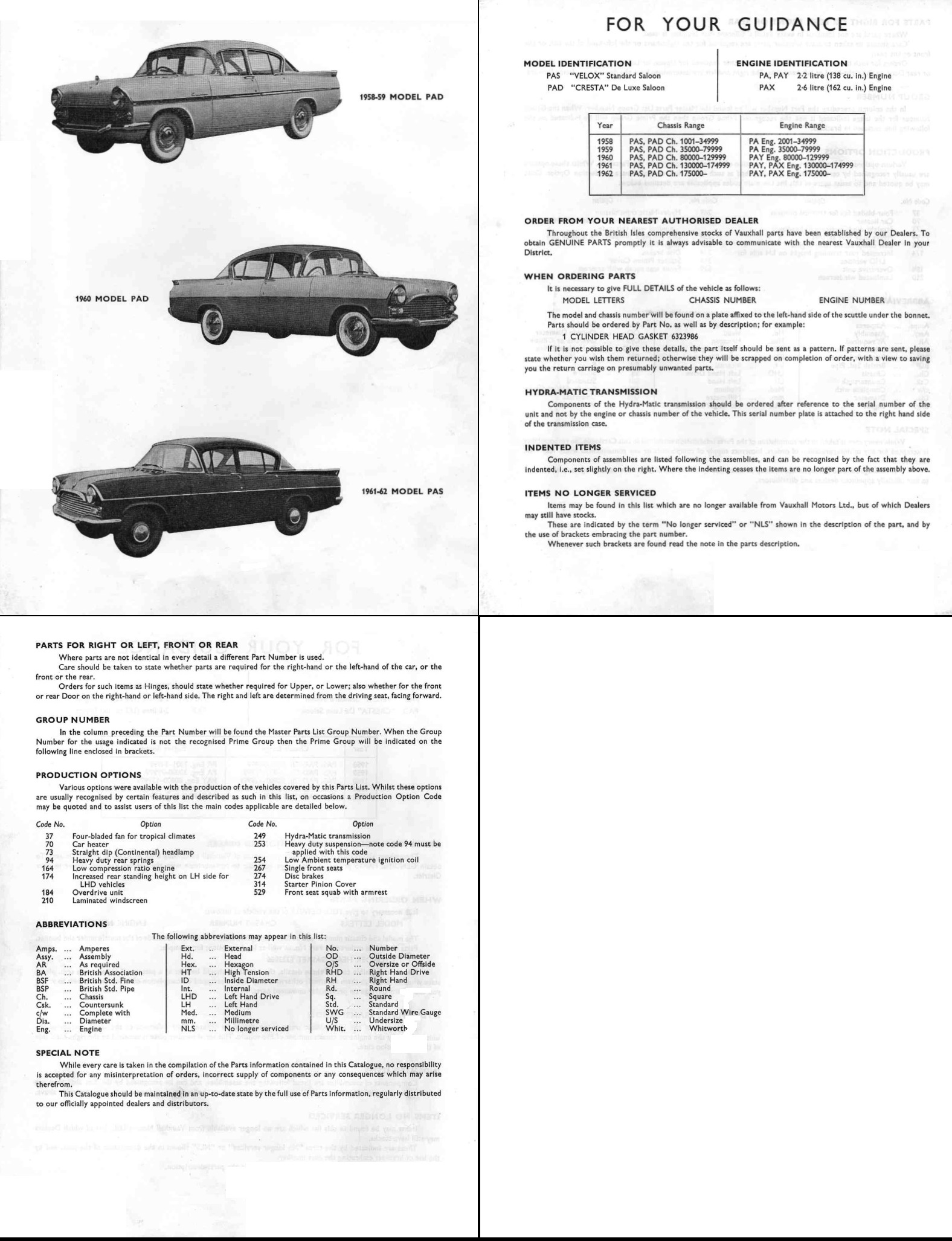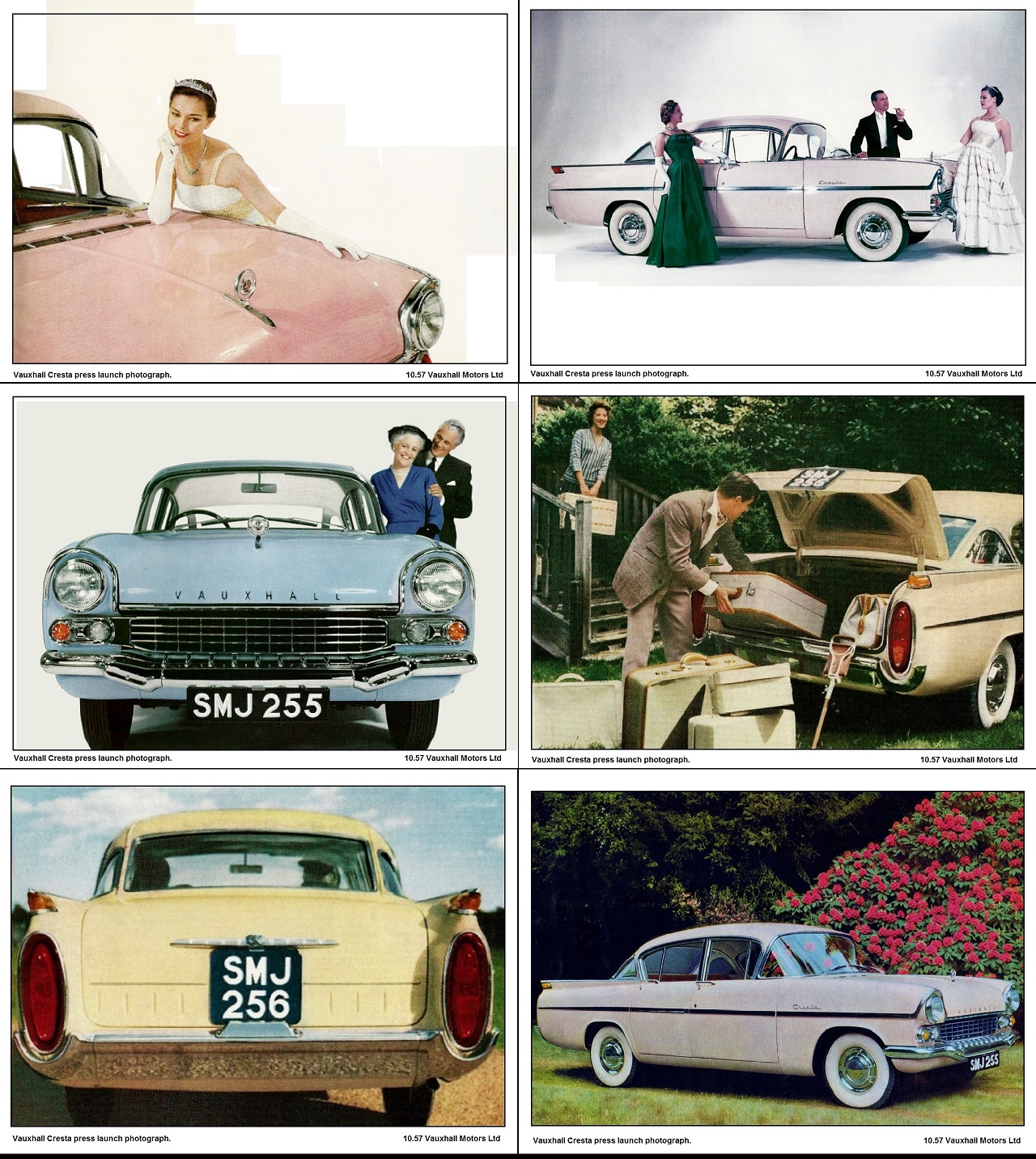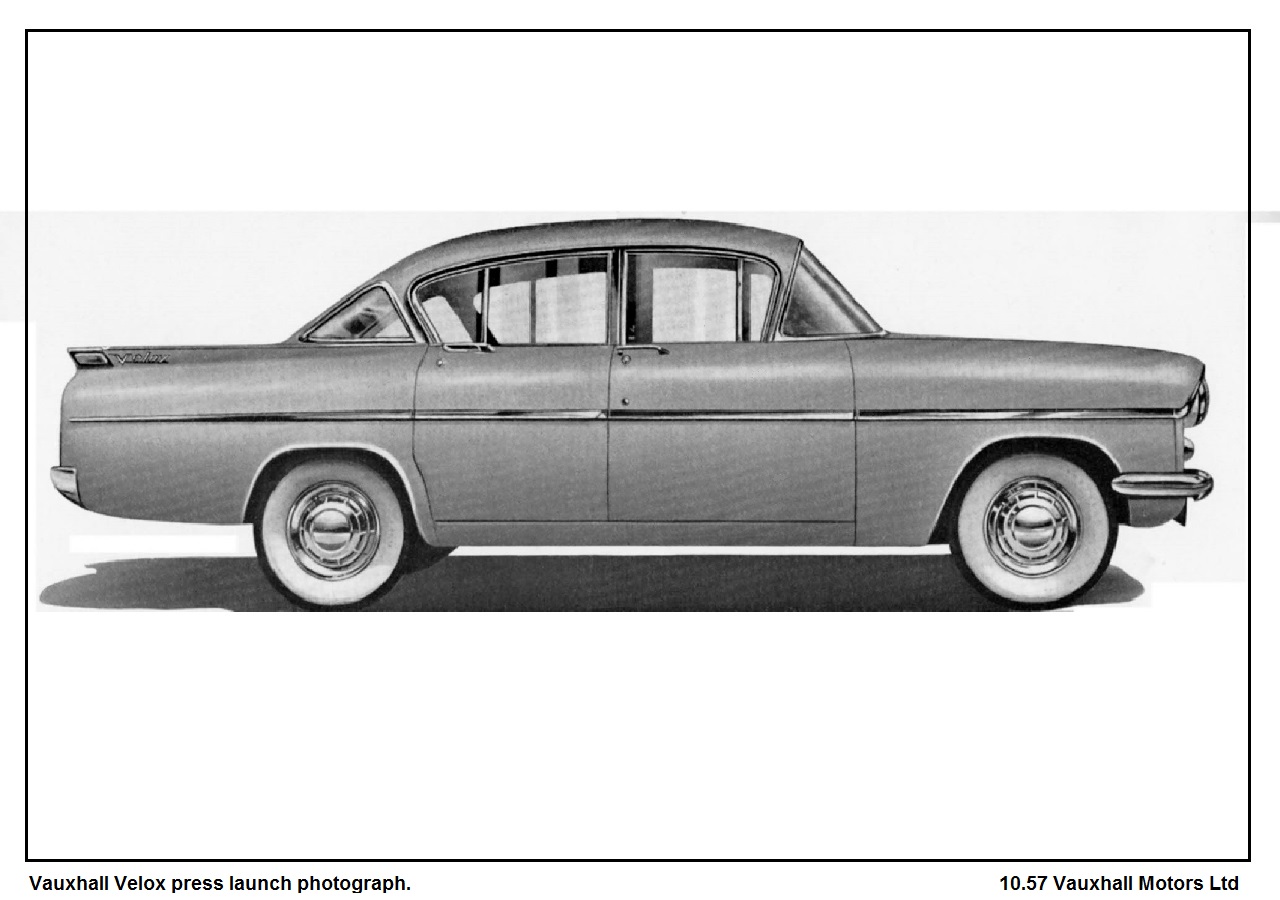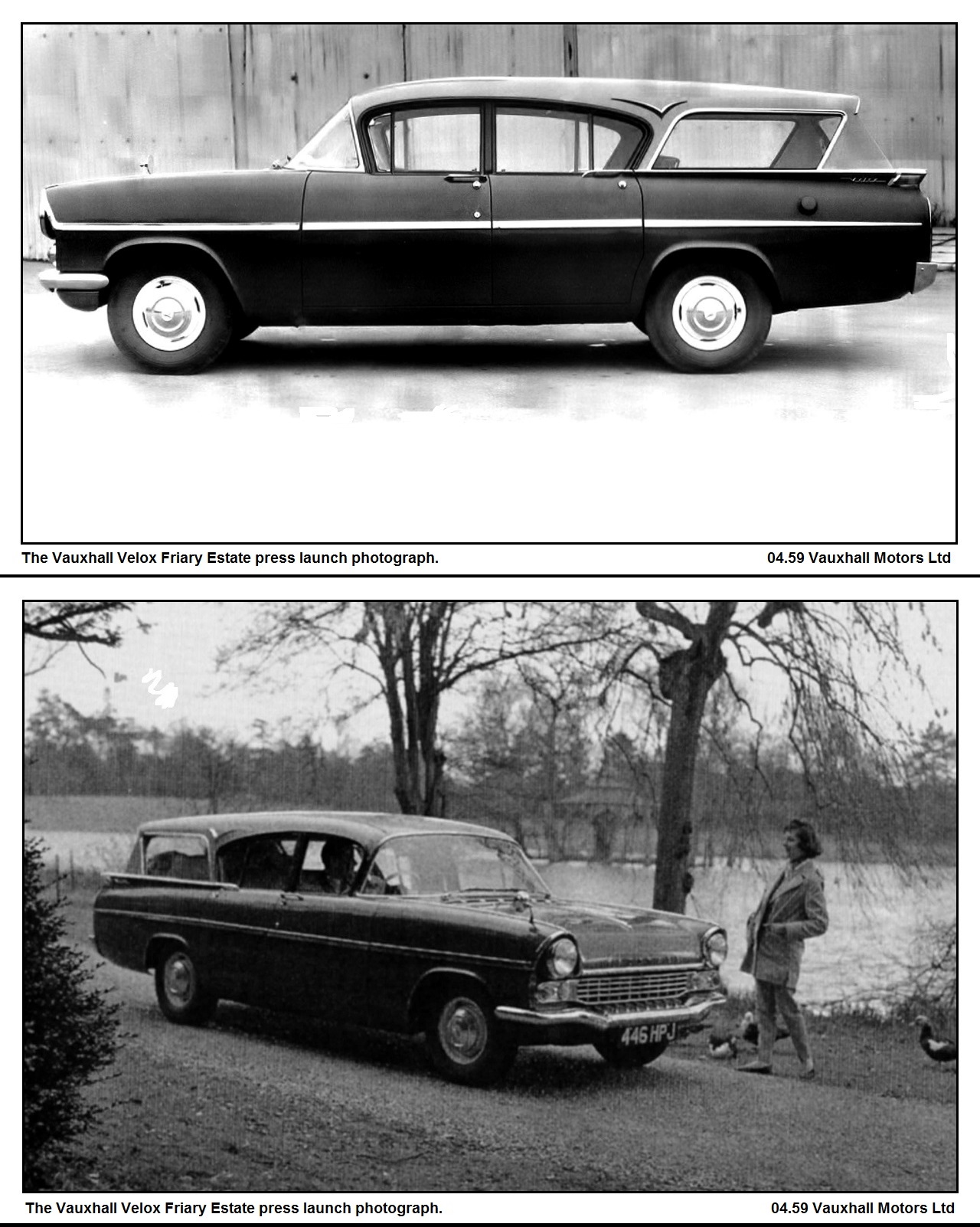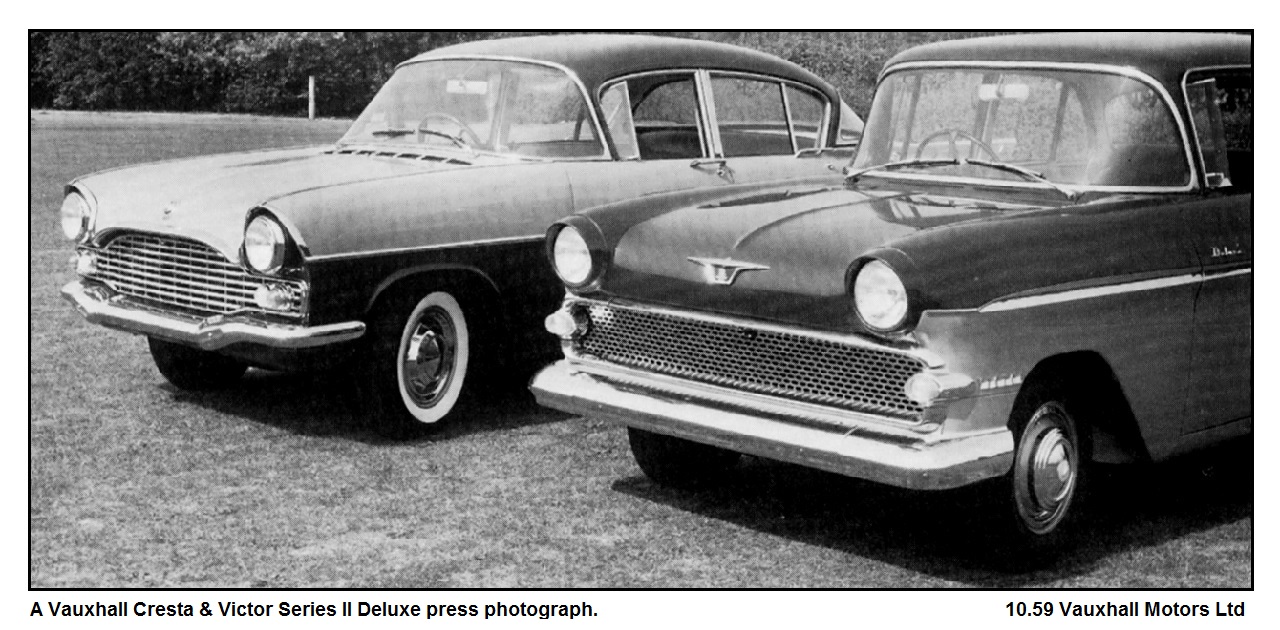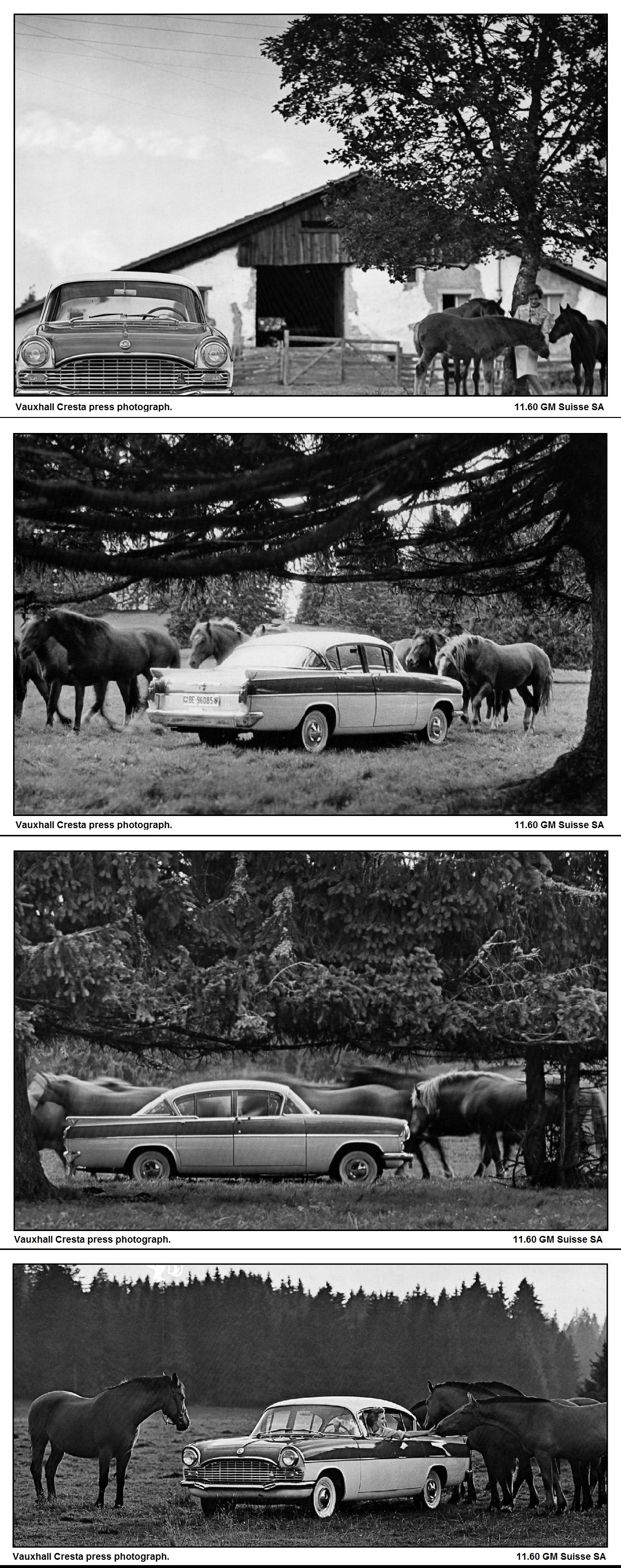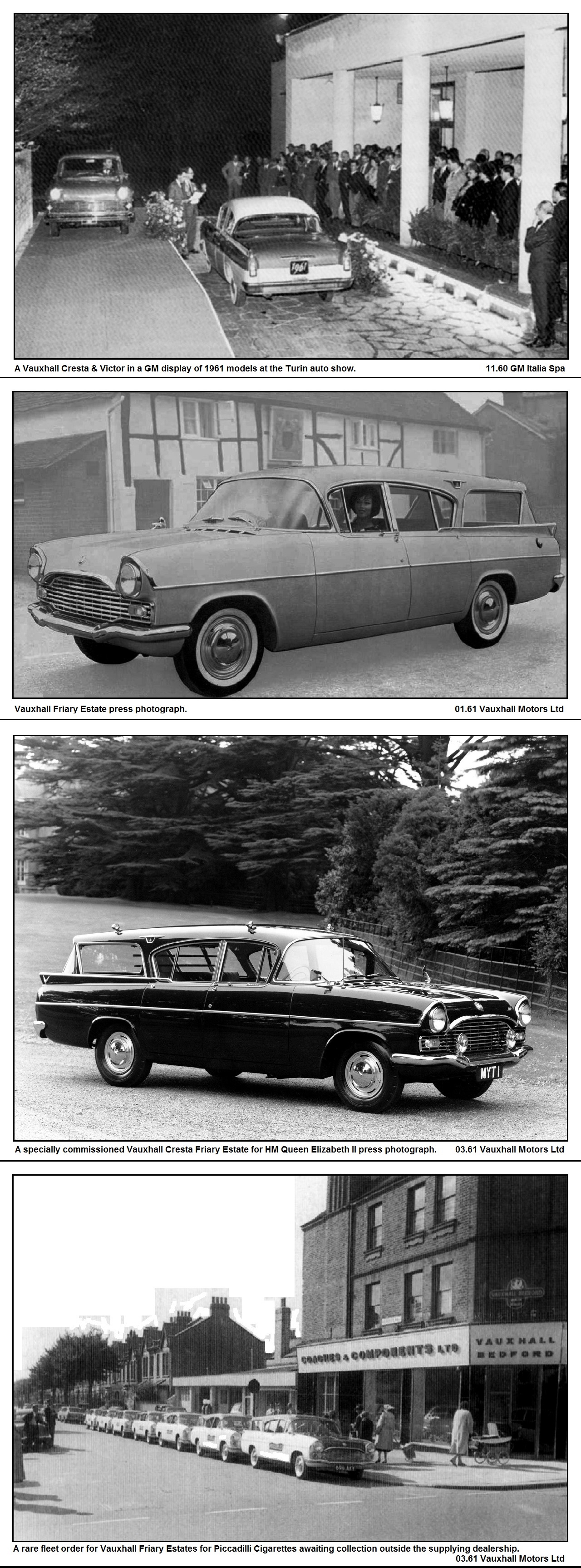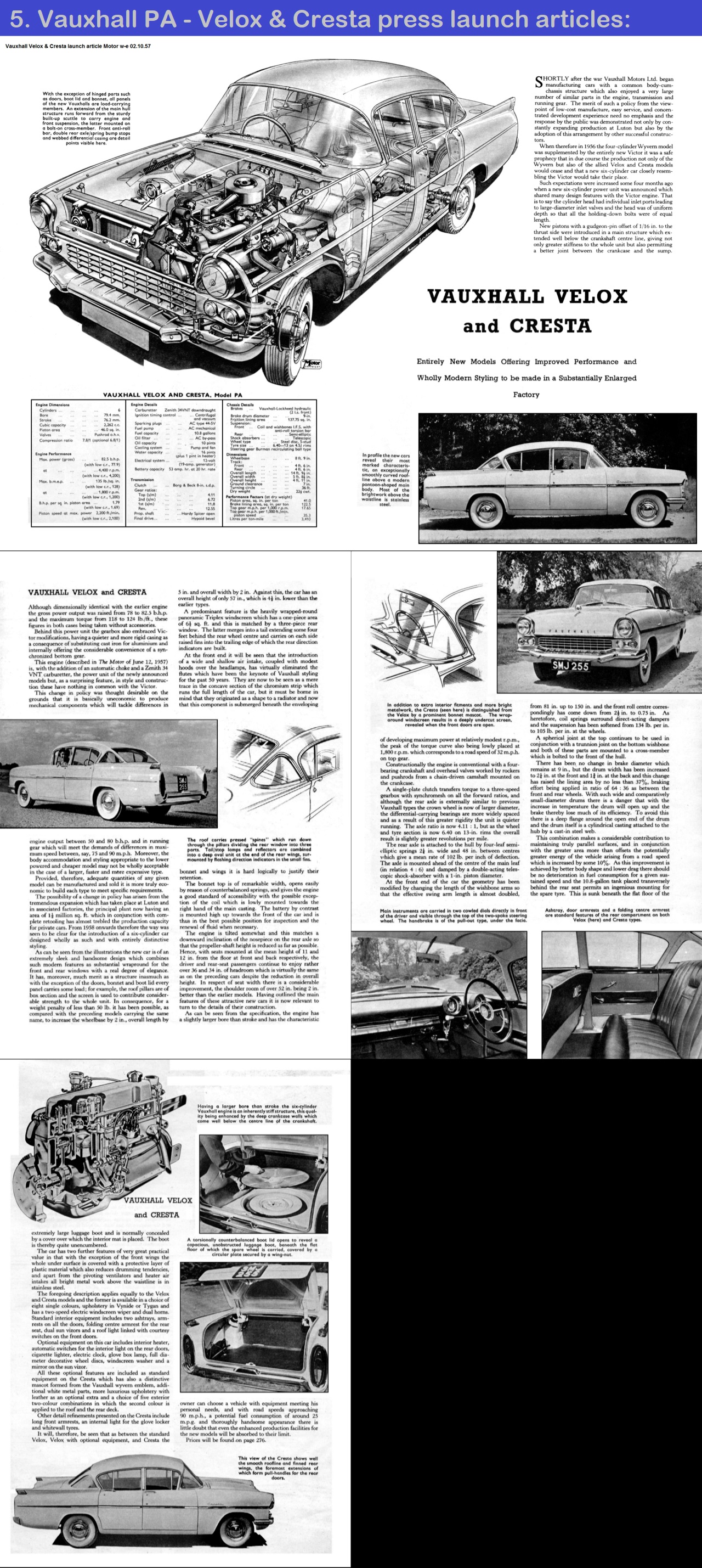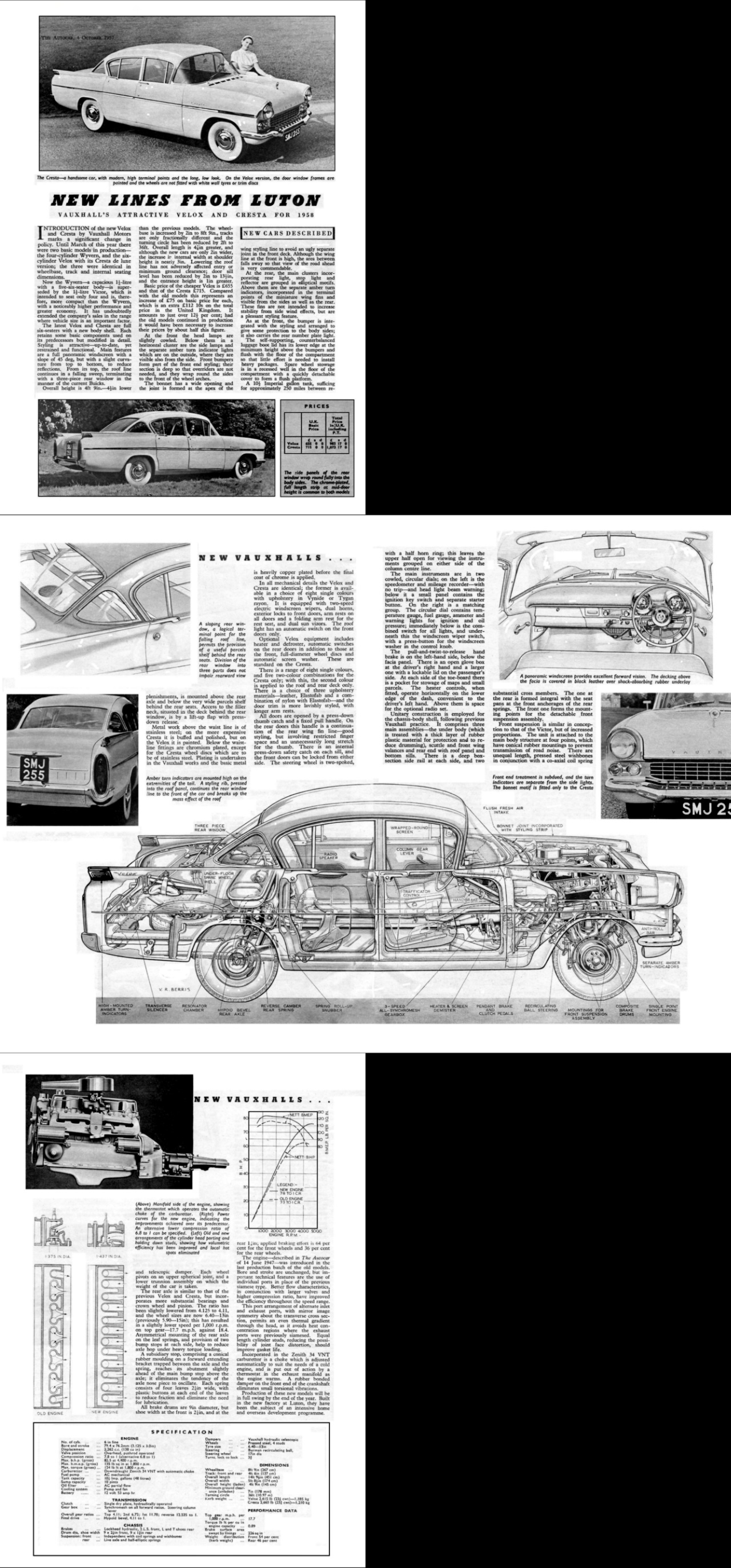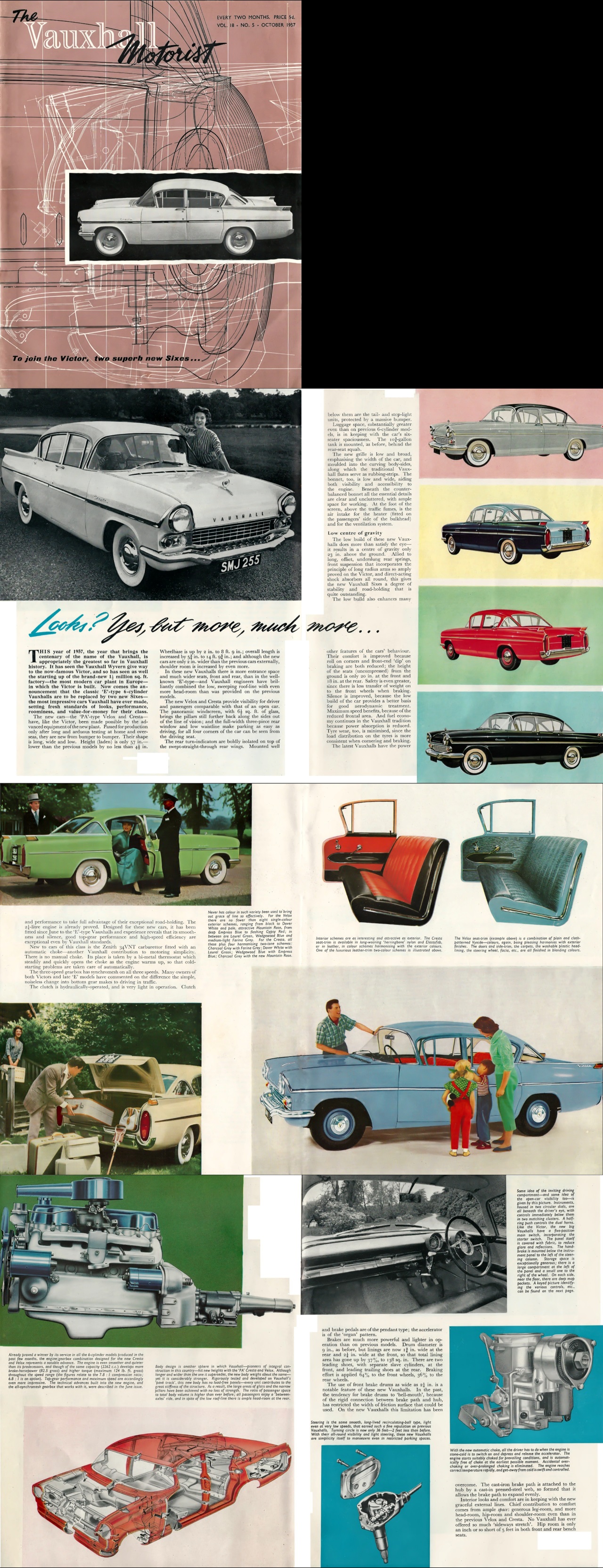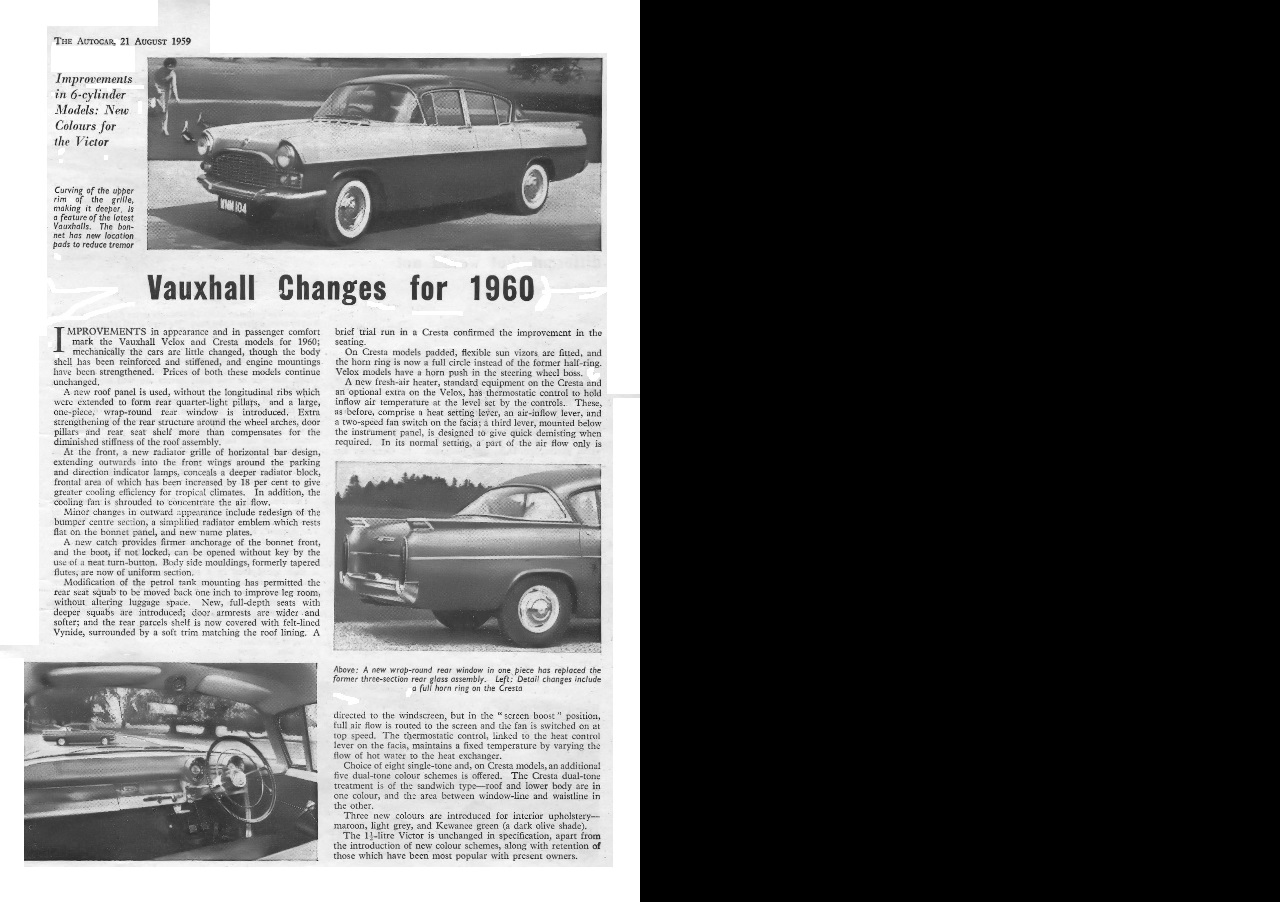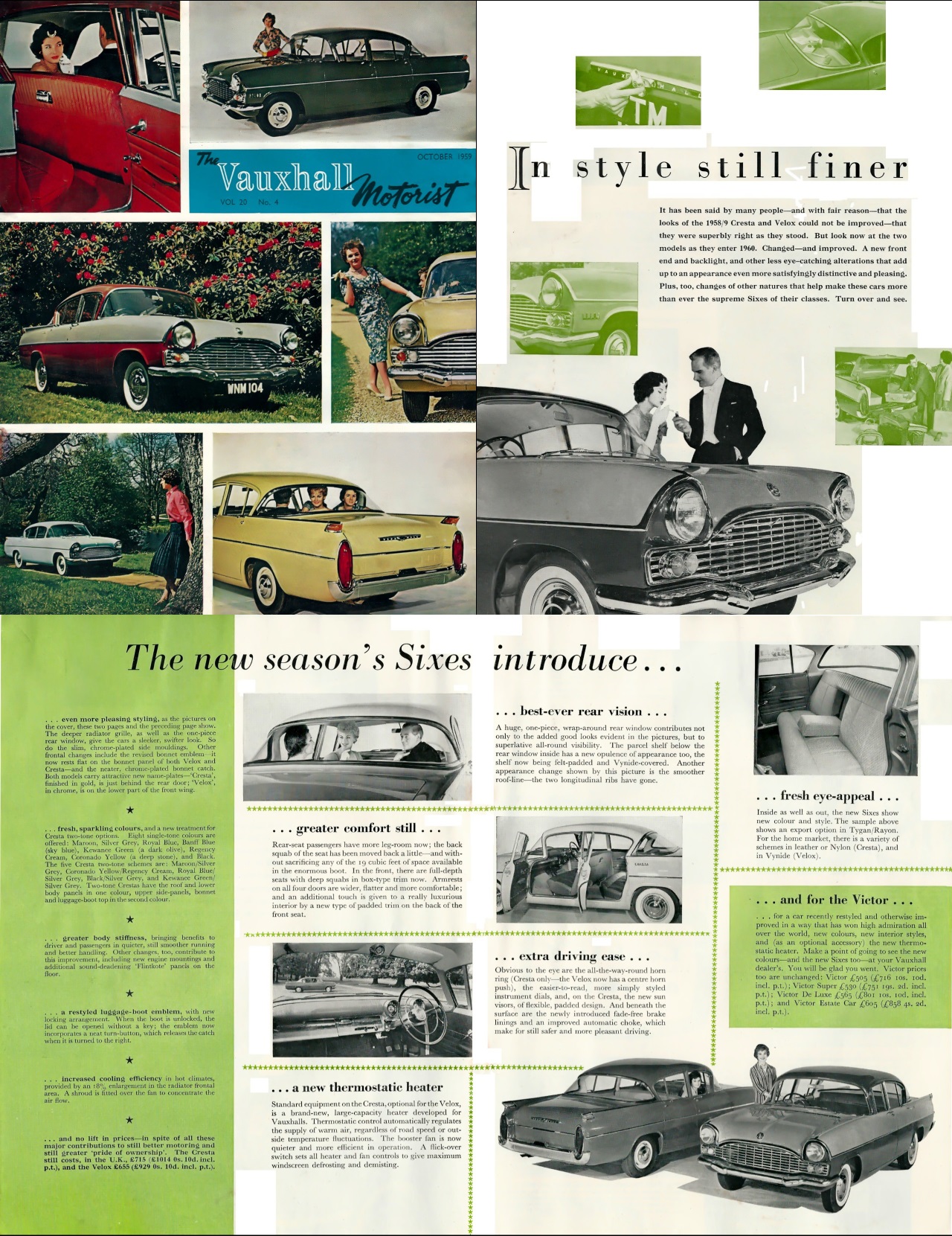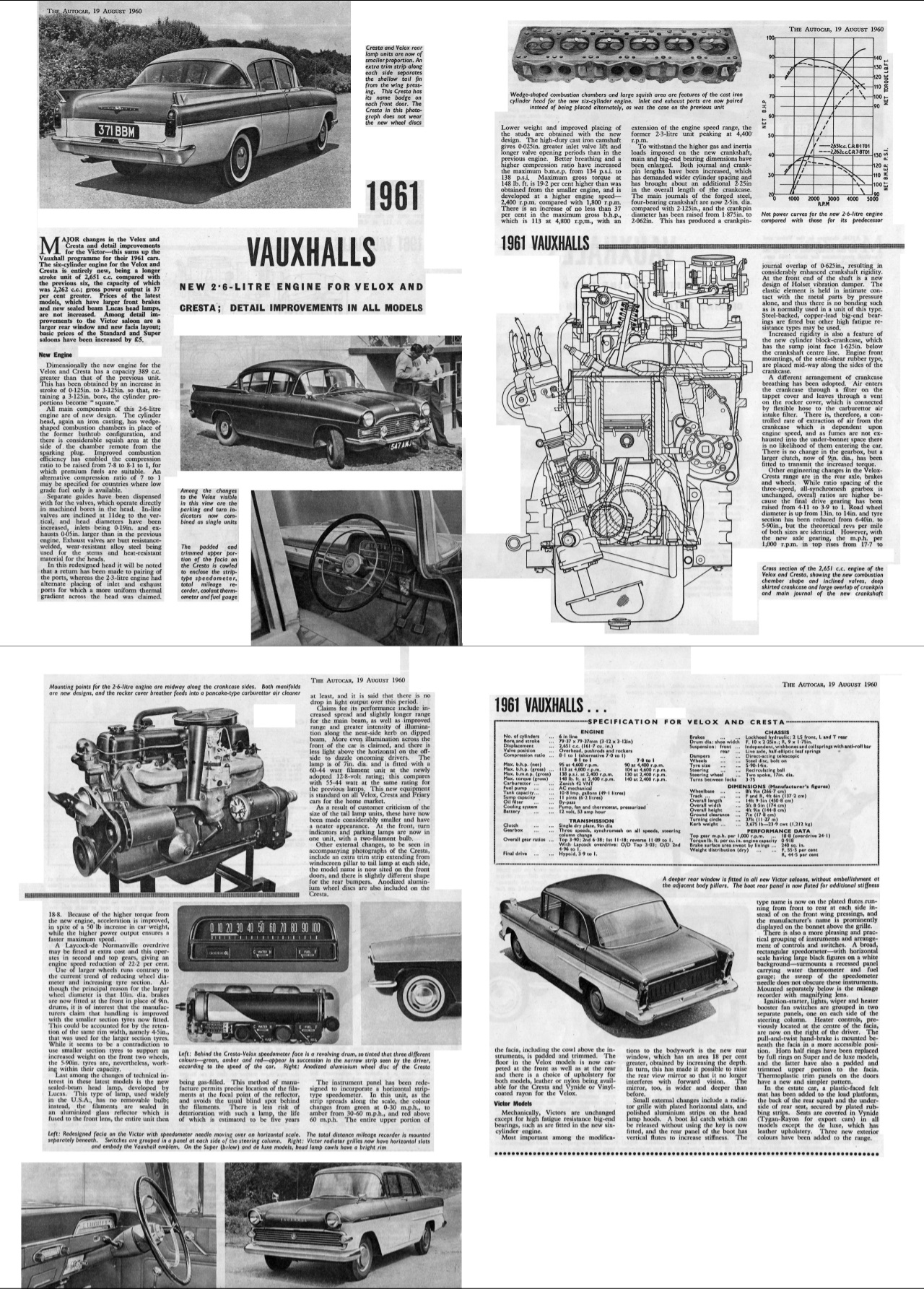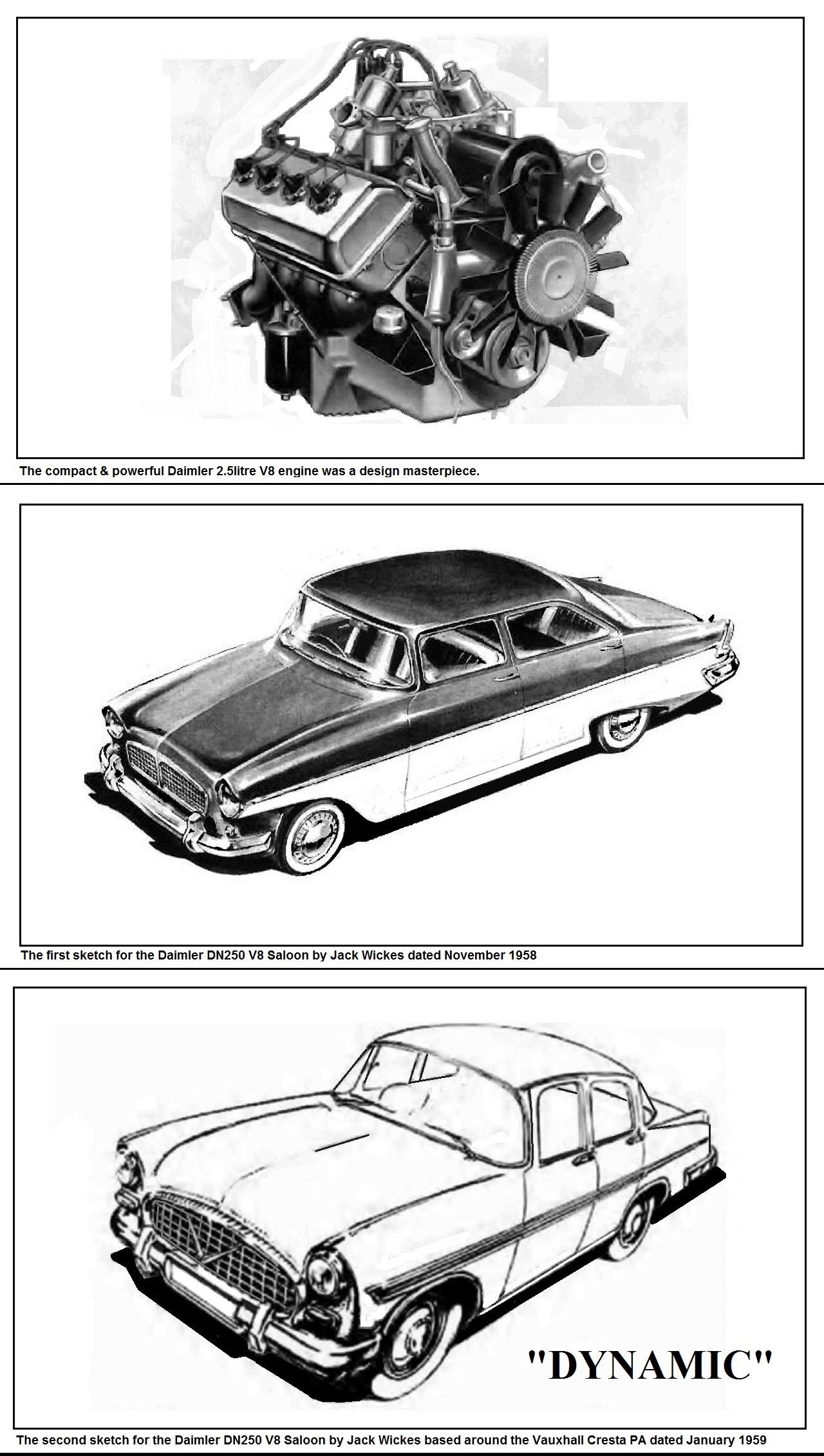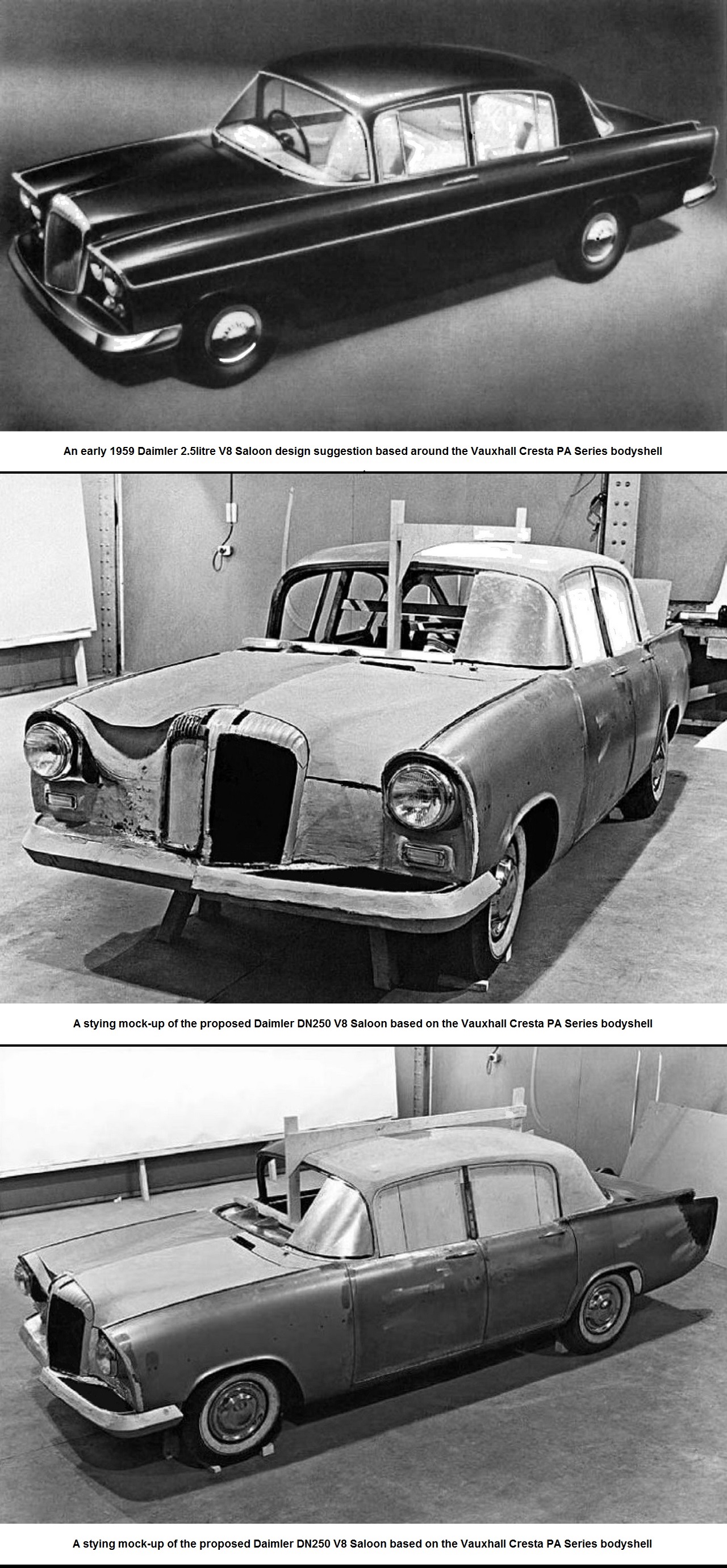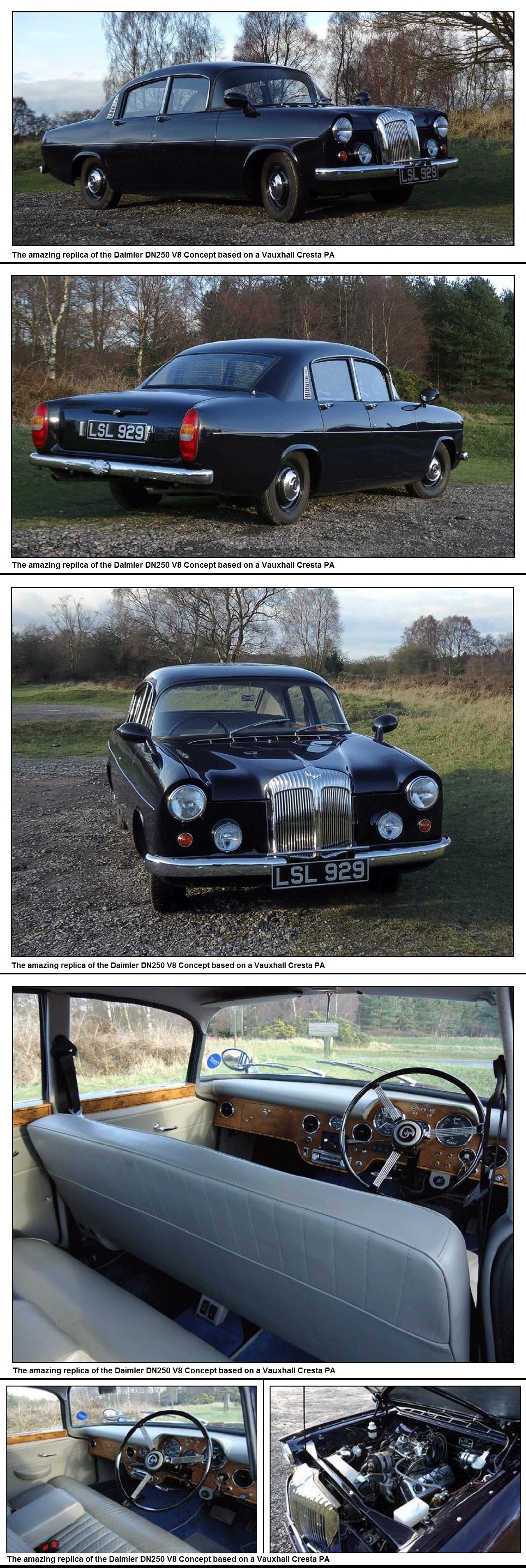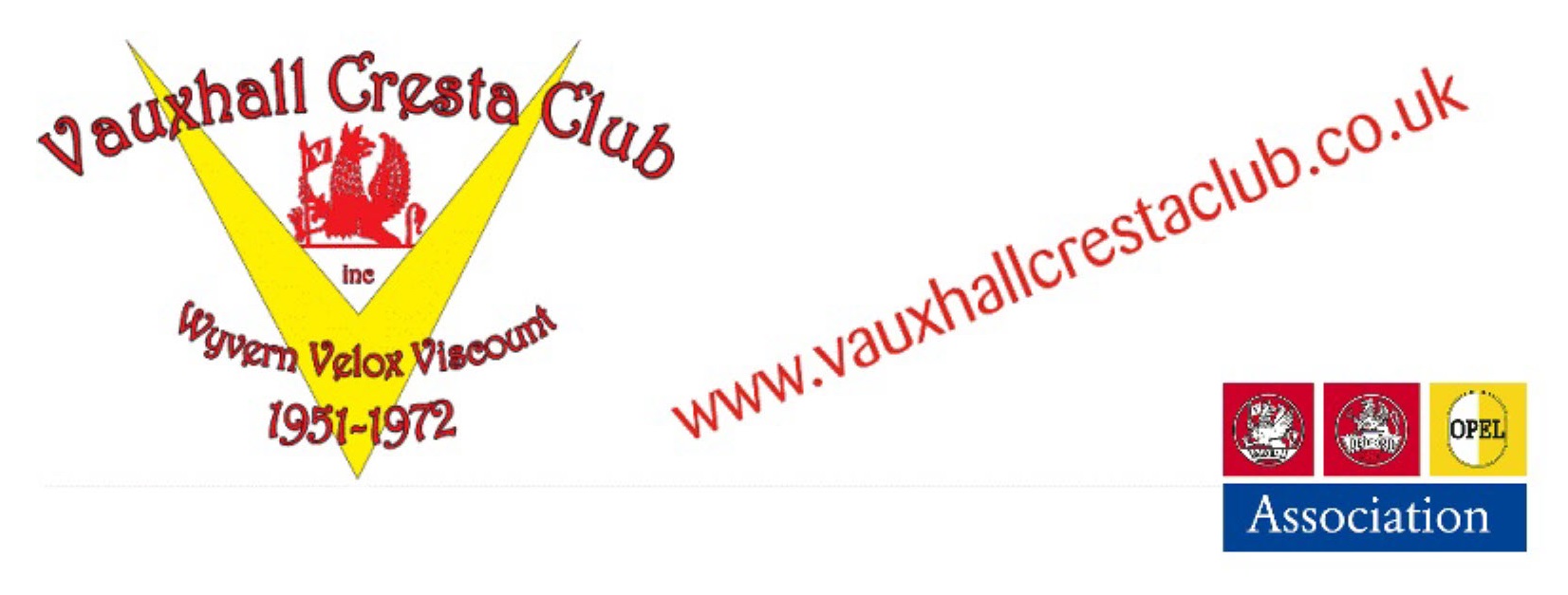The new Velox & Cresta were designed as full 6 seater cars and
filled the purpose better than their predecessors. Main exterior
styling features were of course the front panoramic windscreen
which was slanted at 45degrees with a slight curvature from top to
bottom to reduce reflection. The domed roofline sloped back to a
3-piece rear window arrangement which was similar to that used by
Buick at the time.
Like the Victor design there were no longer any bonnet flutes,
instead being substituted by concave side mouldings. Overall length
increased by just over 4ins and the wheelbase was increased by
2inches to 8ft 9ins although the front & rear track was almost
identical to the E Series, the turning circle was reduced by 2ft to
36ft. Height was reduced by 4.5inches and width by 2inches although
internal shoulder width was increased by 3inches. The deep front
& rear bumpers were now an integral part of the styling and the
front wrapped around the wings. At the rear the huge oval light
units housed all but the indicators which were mounted at the tips
of the tail fins. Counter balanced, the rear boot lid extended down
to bumper level with the spare wheel mounted below the floor. The
boot capacity was the largest of any Vauxhall up to the
time.
A 10.5-gallon fuel tank was mounted above the rear axle behind the
rear seat and used press down release filler cap located at the
base of the rear window. All metal mouldings above the waistline
were stainless steel, buffed on Cresta and painted on Velox models,
below all moulding were chromium plated by Vauxhall at the factory
except for the Cresta wheel discs which were stainless steel. Each
door was opened by push down thumb catch with a fixed pull handle,
on the rear door the pull handle continued as the chrome trim for
the rear wings. Inside push button door locks were fitted all
round. Instrumentation consisted of 2 large circular dials, one a
speedometer and the other housing temperature, fuel & ammeter
gauges and warning lights. A column mounted 3 speed transmission
with an under-dash handbrake were similar to those used on the
previous models. Provision for a radio was built into the dashboard
design but unusually the speaker position was in the middle of the
rear parcel shelf.
he unitary body construction used three main assemblies – the
underbody which was treated with a thick layer of rubber plastic
material for protection and to reduce drumming, scuttle and front
wing valences and rear end with roof panel and bottom sills.
Further, a deep box section side rail was fitted with two
substantial cross members, the rear was formed integral with the
seat pans at the front anchorages of the rear leaf springs. The
front formed the mounting points for the front suspension
assembly.
Front suspension design was like that of the F Series Victor but of
larger proportions. The unit was attached to the main body
structure at 4 points which used conical rubber mountings to
prevent the transmission of road noise. It used unequal length
pressed steel wishbones and co-axial coil springs with telescopic
shock absorbers. Each wheel swivelled on an upper spherical joint
and lower trunnion assembly which supported the weight of the
car.
The rear axle was a modified version of the previous E Series unit
incorporating more substantial bearings, crown wheel & pinion.
A slightly lower axle ratio was used, 4.11 instead of 4.125. With
13inch instead of 15inch wheels the overall gearing was lowered
from 18.4mph to 17.7mph per 1000rpm. The axle was mounted
asymmetrically on the leaf springs with bump stops either side
helped to control axle hop under heavy torque loading. A subsidiary
stop using a conical rubber moulding on a forward extending bracket
trapped between the axle and the spring reached its abutment
slightly ahead of the main bump stop above the axle eliminating the
axle nose piece oscillating. Each 2.25inch wide 4 leaf rear spring
used a plastic button at each end to reduce friction and eliminate
the need for lubrication. Braking used 9inch drums front with
2.25inch wide shoes & rear with 1.25inch shoes, the brake
distribution was 64% - 36% biased to the front.
The exact specification of the engine was surprisingly introduced
in the very last few months of E Series production but was not
widely advertised or promoted by Vauxhall. It did mean that engine
production at Luton was fully established prior to the launch of
the PA models. A new head design was the main change, this used
individual porting instead of the previous Siamese arrangement.
Better flow characteristics, larger valves, new pistons and a
higher compression ratio improved the engine’s efficiency
throughout the speed range. Carburation was by a downdraught Zenith
34VNT fitted for the first time with an automatic choke mechanism
actuated by a thermostat mounted in the exhaust manifold. A rubber
bonded damper was fitted to the front end of the crankshaft to
eliminate small torsional vibrations. Gross power output increased
from 78bhp to 82bhp and torque from 118 to
124lb.ft.
Like the Victor the 3-speed transmission now featured synchromesh
on all gears, it also used a more rigid aluminium
casing.
The Vauxhall PA Velox & Cresta prototypes were extensively
tested from mid-1956 onwards, this included the Chaul End proving
ground and also in Europe, particularly in Switzerland. The cars
were always painted plain black with no badges or chrome fittings
as well as being loaded with test equipment and recording systems.
The cars were also subject to regular evaluation at the GM Millford
Proving Ground in the US.
Almost as soon as the new Velox & Cresta models were announced
work began on a facelift to be ready for the 1960 model year. Work
on the project was carried out at Luton and also Detroit where a
very dramatic window arrangement as well some styling cues from the
upcoming Chevrolet Corvair.
3. VAUXHALL VELOX & CRESTA LAUNCH AND MODEL
HISTORY:
Series production began at Luton on 10 October 1957 and the new
Vauxhall Velox & Cresta were announced in the press on 02
October 1957. They were given their first public showing at the
Paris Motor Show and immediately after at the London Motor Show.
Compared to the dreary offerings from BMC, Ford & Rootes the
Velox & Cresta stunned the press and car buying public alike.
Compared to the previous E Series models the PA was a revelation
not only in style but also in the flamboyant colour schemes it
could be ordered with. Despite using similar design cues to the
Victor, the new cars were deemed far more attractive and, unlike
the Victor, received universal acclaim. Noted were the attractive
“harmonica” front grille with the upright Vauxhall griffin badge
acting like a jewelled crest on the front of the bonnet, although
American influences were obvious & acknowledged they had been
incorporated in the most stylish fashion. Prices were increased
about 12.5% compared to the previous models but, according to
Vauxhall at the time, if they had continued in production their
price would have increased by 6% anyway.
Other
than the unusual panoramic view of the outside, the interior of the
Velox & Cresta was far more conventional in design, more of an
evolution of the previous models although they now provided easy 6
seat accommodation. Both models were well equipped, the Velox came
as standard with armrests on all doors, rear seat centre armrest,
no draught ventilation, dual sun visors, 2 speed electric wipers,
Vynide trim and a choice of 8 exterior colours. The Cresta was
differentiated from the Velox by a standard heater & 2 speed
blower fan, either leather or Elastofab upholstery, electric clock,
vacuum operated windscreen washer, cigarette lighter, lockable
glove box, rear door courtesy lights, boot light, bonnet emblem,
whitewall tyres, full cover wheel discs, stainless steel side
window & centre pillar mouldings and an addition choice of four
2-tone exterior paint finishes.
Both
Velox & Cresta were available with two compression
ratios:
6.8:1
which gave 77.9bhp @ 4,200rpm – 117.6lb.ft @ 1,200rpm for standard
low grade fuels and primarily aimed at export
markets.
7.8:1
which gave 82.5bhp @ 4,200rpm – 124.0lb.ft @1,800rpm for what was
termed at the time premium
fuels.
Some
of the earliest cars were not particularly well built, in fact even
the press launch photographs show some patchy build quality.
Vauxhall waited longer than usual to release cars for road testing
by Autocar and Motor presumably to ensure production had bedded in.
Sales were strong from the start and the cars were just as popular
in export markets.
Changes for the 1959 model year were minimal, the cars continued to
sell in large numbers. Velox models used revised pleated Vynide
upholstery and a new range of colours but with the choice reduced
from 8 to 7. On the Cresta the seat trim design was revised and the
new colours were available in four 2-tone & 8 single colour
finishes, Laurel Green was exclusive to the Cresta. A front seat
folding centre armrest became a new option for both models. The
compression ratio for home market cars was now standardised at
7.8:1 with the lower 6.8:1 ratio only available on export versions.
A reinforced bonnet, wider opening front quarter lights and felt
underlay for the rear parcel shelf were further revisions. On 06
February 1959, the 2,000,000th Vauxhall rolled off the
production line at Luton – a Vauxhall Cresta. In May 1959, a new
Estate conversion became available from outside coachbuilder Friary
Motors but was factory approved and sold through all Vauxhall
dealers. Vauxhall had already considered a factory produced Velox
& Cresta Estate but deemed the market too small to justify the
capital investment so instead passed the design drawings to Friary
for their use in the version they ended up
producing.
The Vauxhall Velox & Cresta were never marketed as in any way
sporting cars, however this did not stop two privately entered
Vauxhall Cresta models taking part in the 29th Monte Carlo Rally in
1959. In Britain, an Army Team used a Vauxhall Velox to take part
in several rally events around the
country.
Always aware of transatlantic trends the Velox (PASY) & Cresta
(PADY) were given a facelift in October 1959 for the 1960 model
year. David Jones had toyed with several different rear end
treatments but settled on a new single piece rear window and
deletion of the ribbed roof strengthening giving a smoother roof
profile. To compensate the rear parcel shelf, door pillars and
wheel arches were strengthened suitably strengthened. The
front facia panel featured a larger (and to most eyes far less
attractive) front grille along with simplified chrome trim outside,
smoother front bumpers, a new larger capacity radiator, improved
heating system, and inside new seating & trim which combined
with a repositioned fuel tank gave an extra inch of rear leg room
and wider door armrests. Laycock overdrive on 2nd and top gear was
also now available as an extra cost option, this also necessitated
a larger transmission tunnel fitted to all models. Velox was now
offered in 8 exterior colours while the Cresta 2-tone paint schemes
were re-arranged and available in 4 choices plus the 8 single tone
colours. A new design of boot lock introduced. Changes to the
engine valve gear reduced noise and slightly raised the power peak
to 4,400rpm and new design engine mounts fitted. Model
identification badges were changed, VELOX was mounted on the lower
forward section of the front wings while CRESTA was mounted on the
side under the rear screen pillar. The redesigned, flatter bonnet
used a flush mounted Vauxhall badge instead of the previous bonnet
mascot.
The 1961 model year changes for Velox (PASX) & Cresta (PADX)
were announced earlier than usual in late July 1960, surprising
also because the update involved sheet metal, engine, transmission
as well as trim updates. Mechanically, the biggest change was the
introduction of a new larger version of the 6-cylinder engine. The
capacity was increased from 2262cc to 2651cc achieved by increasing
the bore & stroke to an exactly “square” 82.55mm each, the
compression ratio was also increased slightly to 8.1:1. Power
output was a healthy 113bhp at the same 4,800rpm as before while
torque increased to 147lb.ft @ 2400rpm. The previous engine
continued to be available in some export markets such as Velox
models for Switzerland. Vauxhall had been experimenting with
fitting automatic transmissions to Velox & Cresta models for
the previous two years, the 3 speed Hydra-Matic and useless 2 speed
Powerglide units – both from GM. This testing had highlighted the
need for a larger more powerful engine and was the main reason for
its introduction. Fortunately, the 61-05 Hydramatic transmission
was the one chosen for the PA and offered as an expensive option
for the 1961 cars. With the larger engine and a top speed of 94mph,
the Velox & Cresta moved to near top of their class for
performance and fitted in with Vauxhalls advertising at the time -
“Built for the Motorway Age”. Other mechanical changes included a
1inch larger clutch, larger diameter front brakes which also meant
fitting larger 14inch wheels, the rear axle ratio was lowered from
4.11:1 to 3.90:1 and therefore raised the overall gearing. Tyres
were changed to 5.90x14 and the turning circle increased from 36 to
39ft.
As usual there were revised colour choices, 9 single tone for both
Velox & Cresta and no less than seven 2-tone choices for the
Cresta only. At the rear, the cars used new rear light units,
revised larger tail fins without indicators built in and a “V”
motif mounted at the tip and a revised boot lid and bumper design.
At the front, new sealed beam headlights and oblong combined side
& indicator light units were fitted. Model names were mounted
on the front door upper panel, gold on Cresta, with an additional
chrome strip from front doors to the rear. Interior changes
included a completely new instrument panel using a “Magic Ribbon”
strip speedometer - the strip indicating speed changed from green
to amber at 30 mph and to red at
60 mph.
For the last model year of Velox (PASX) & Cresta (PADX)
production, the 1962 models were available with 10.5inch Lockheed
servo assisted front disc brakes as an option and still rare for a
volume family car at the time. New 14inch wiper blades dramatically
increased the swept area of the windscreen which now included a
“safety zone”. Paint finish was changed in-line with the new Victor
FB and used synthetic cellulose enamel for the first time.
The colour choice widened to 14 single tone on Velox, 15 on
Cresta and eight 2-tone schemes for Cresta only. The Cresta
exterior badges were claimed to be gold plated. 11inch wipers were
replaced with 14inch dramatically increasing the swept area of the
screen, the windscreen itself was now toughened glass with a safety
zone in the middle. Inside the seat trim design was revised, the
Velox used deep pile carpets and individual front seats were now an
option for the first time. Twin – 2 pivot – padded sun visors were
standard, the front ashtray was moved to the top of the dashboard
which now included a 110mph speedometer with larger warning lights,
a full circle horn ring was standard, on Cresta models grab handles
were fitted for rear passengers and carpeting was a thicker tufted
pile with thick felt underlay, both versions now featured a
simulated wood dashboard and door cap finishes with larger &
softer door armrests. The advent of the restrained style FB Victor
in October 1961 customers knew that it would only be a short time
before a new Cresta & Velox would be launched with similar
styling and sales in the last year dropped off markedly, and sure
enough the PA Series models were replaced by the PB models in
autumn 1962.
The Velox & Cresta Estate cars converted by Friary of
Basingstoke, Hampshire became famous when a specially commissioned
car for HM Queen Elizabeth II was built, it was in service right up
until the early 1980s when it was replaced by a specially built
Viceroy Estate
There were a number of prototype ideas that Vauxhalls design
department flirted with, one was a 2 door Cresta fastback coupe and
was said to be quite attractive in an even more overt American way
than the 4 door but it never got past the clay mock up stage. The
other was an ultra-luxurious version kitted out with leather, real
wood for the dash and door capping’s, wool cloth headlining and
electric windows and picnic trays on the backs of the front seats.
It was also fitted with an up-rated version of the 2.25 litre
engine with twin Zenith carburettors and used as David Jones
personal transport for a while – the nickname given to the car?
Viscount!!
During the 1970s many PA models were modified or customised by
1950s revivalists and the cars were synonymous with the Teddy Boy /
Rock n Roll image. A 1960 PA Cresta also featured in the 1981 video
for the track Ghost Town by the Specials.
4. VAUXHALL PA - VELOX & CRESTA PRESS
PHOTOGRAPHS:


